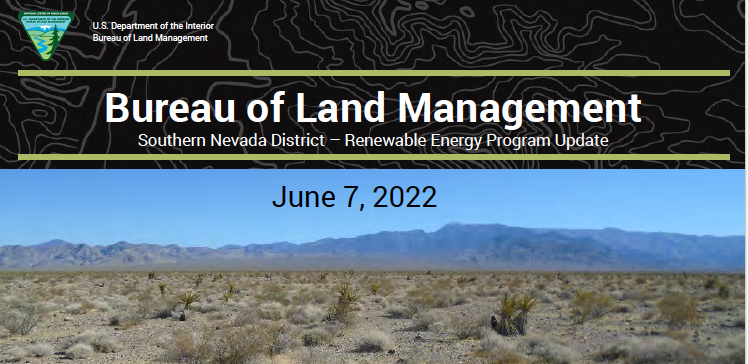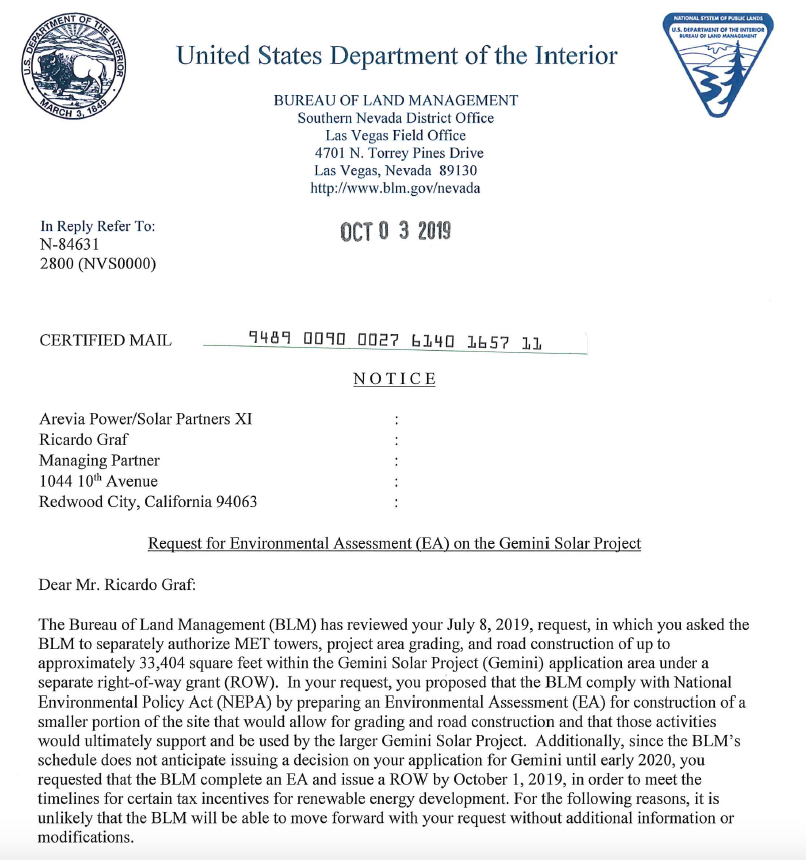Southern Nevada Renewable Energy Projects Update
June 9, 2022 - Las Vegas, NV - The Southern Nevada District of Bureau of Land Management released this slide deck in PDF form of a useful summary of all solar and wind applications in Clark County and Nye County south of Beatty. See the BLM Southern Nevada District Renewable Energy Program Update PDF.
Gemini Solar Project Approved, Bernhardt Visits
^Silver cholla will be mowed down or bulldozed, site of approved massive utility-scale Gemini Solar Project.
May 11, 2020 - Near Valley of Fire State Park, NV. Despite a global pandemic, with many Americans still in lockdown mode, the federal government went full steam ahead with projects on public lands. The Bureau of Land management (BLM) approved the 7,000-acre, 690-megawatt Gemini Solar Project today, allowing solar developers to begin construction operations.
The Department of Interior said: "The Trump Administration remains committed to its America First, all of the above approach to domestic energy production as the Department of the Interior (Department) and the Bureau of Land Management (BLM) announced today the approval of a proposal to construct and operate the largest solar project in United States history."
Interior estimated that the $1 billion Gemini Solar Project could be the eighth-largest solar power facility in the world when finished and is expected to generate electricity for Nevada markets, but also potential energy markets in Southern California--despite the growing overgeneration problem in California caused by too many utility-scale solar projects feeding the grid simultaneously.
The hybrid alternative specified in the Record of Decision includes a mowing method that BLM claims will reduce impacts to the federally threatened Mojave desert tortoise. "Extensive long-term monitoring will be required, in addition to possible adaptation of methods used to reduce potential impacts to desert tortoise," the Interior press release said. We beleive the significant impacts to the tortoise will be large and not be mitigated.
Lithium battery banks will also be utilized, yet summer temperatures here can reach 115 degrees F, and the batteries will need to be kept at a precsiely cooled temperature. We have yet to view how much parasitic load is needed to cool the batteries in this hot low desert enviromment.
Basin and Range Watch obtained Freedom of Information Act (FOIA) documents showing that the Gemini Solar Project was thought important enough to hold up as an example of renewable energy development by the Trump Administration, that on January 22, 2020, Interior Secretary Bernhardt apparently personally visited the site, accompanied by an entourage of BLM VIPs, including the Nevada State Director Jon Raby. On the itinerary was to show the Secretary the Threecorner milkvetch, (plant mentioned most in comments on Draft EIS"--undoubtedly in reference to our comments, listing petition. Secretary Bernhardt was also shown "Show high density tortoise locations within Gemini project area." On stop 2, the group was shown a segment of the Old Spanish Trail which would be taken out for the solar field.
Basin and Range Watch protested the decision, but it seems BLM lost our protest. We are investigating this.
See the Department of Interior press release here. And "This Week At Interior" YouTube video version.
Basin and Range Watch quoted in the Las Vegas Sun.
Gemini Solar Project Nearing Approval
^Muddy Mountains Wilderness Area as seen from upper California Wash next to the vast proposed utility-scale solar project.
March 19, 2020 - Near Valley of Fire State Park, Nevada - The Bureau of Land Management (BLM) is about to sign off on the final approval for the 7,100 acre (11 square mile) Gemini Solar Project located on public lands in Clark County, Nevada on the entrance road to Valley of Fire State Park. The site is one of the most biologically diverse locations that the BLM has chosen to sacrifice for rooftop compatible solar panels. On recent field trips, we found a baby desert horned lizard, extensive biological soil crusts and extensive burrows for desert kit foxes on the south project site. The BLM estimates that over 1,200 Federally Threatened Mojave desert tortoises will be impacted by this boondoggle and will have to be relocated. The BLM intends to allow the tortoises to re-enter the site after they cover it with solar panels and scrape the habitat to oblivion. Everything in these landscape photos will be bulldozed. Biological soil crust stores C02 and can take a century to grow just an inch in the Mojave Desert. This desert horned lizard along with millions of other living organisms will be crushed alive.
These are the "before" photos. We will try to take consttuction and "after" photos.
^Color Rocks in Muddy Mountains Wilderness Area, a few miles from the proposed massive Gemini Solar Project development.
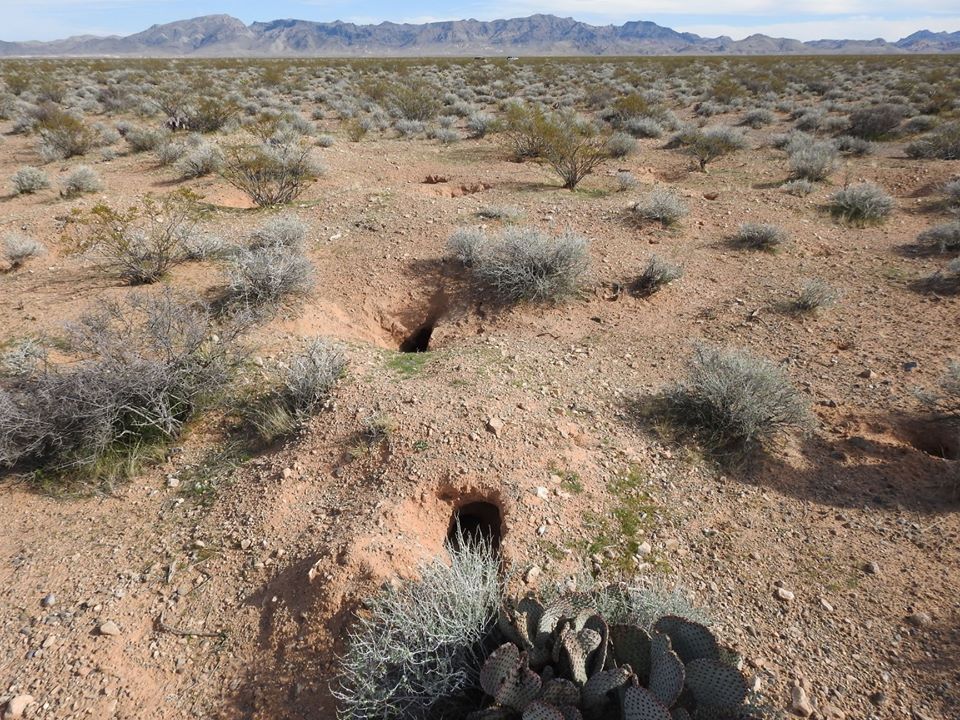
^On the site of the proposed Gemini Solar Project in California Wash, Nevada. Desert kit fox burrow system. Because Mojave desert tortoises often share these burrows, these kit fox burrows will need to be dug out and any tortoises translocated off the site. Kit fox families will be passively hazed out of their burrows before construction machinery arrive, but the kit foxes will then have to fend for themselves and find a new home.
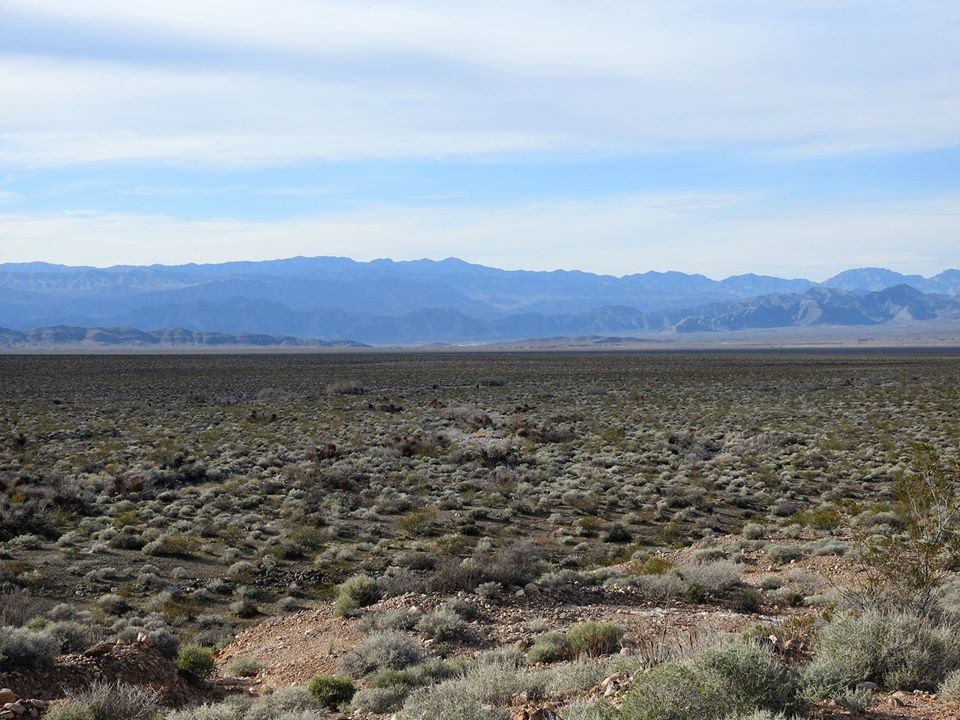
^View of the vast California Wash looking westward towards the Sheep Range. Most of this area will be developed for a large-scale energy project, destroying over 7,000 acres of pristine Mojave Desert habitat. Photovoltaic panels should go on rooftops in Las Vegas, and over parking lots, not on these wildlands.
^Juvenile Desert horned lizard found on the project site. March 2020.
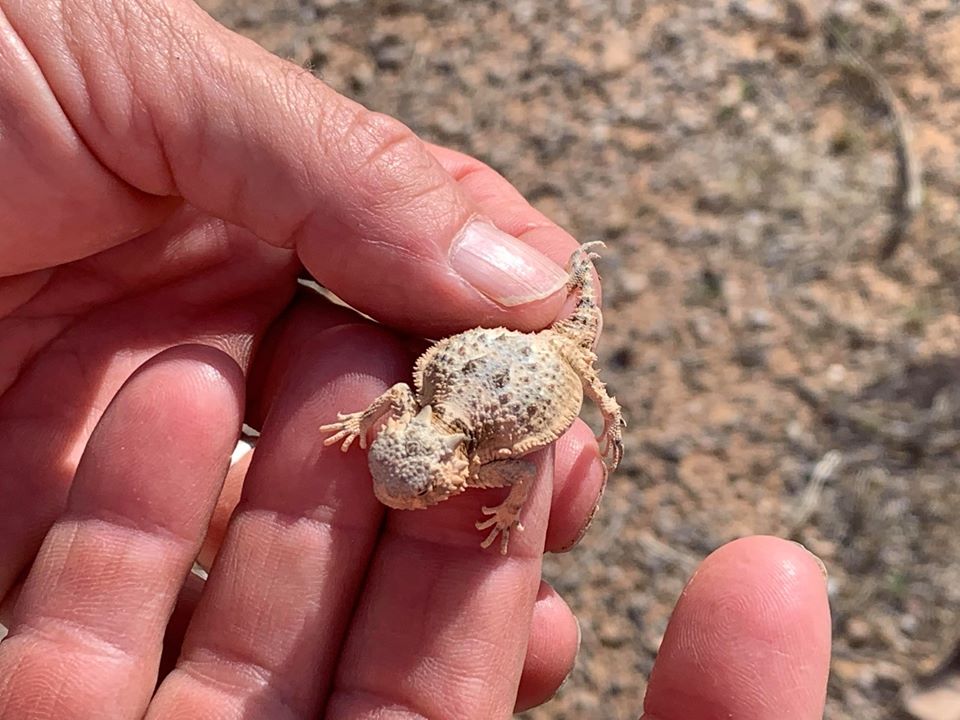
^Baby desert horned lizard on the proposed project site. These reptiles are not protected and will be bulldozed for the energy project. How is this "green"?
^We were impressed by the extensive and rich Biological Soil Crusts across the proposed Gemini Solar Project site. These living soil crusts consist of cyanobacteria, fungi, liverworts, and mosses. In the dry season they are dormant and appear blackish-gray and arid. But with rains they come back alive and green up. Biological soil crusts such as these are delicate and will not grow back for decades. They sequester large amounts of carbon, and hold desert soils together against dust storms, and also help retain rainwater. Destroying such life makes no sense to us.
^Extensive Biologcial Soil Crusts, which store carbon. These Mojave Desert ecosystems should be conserved, not developed.
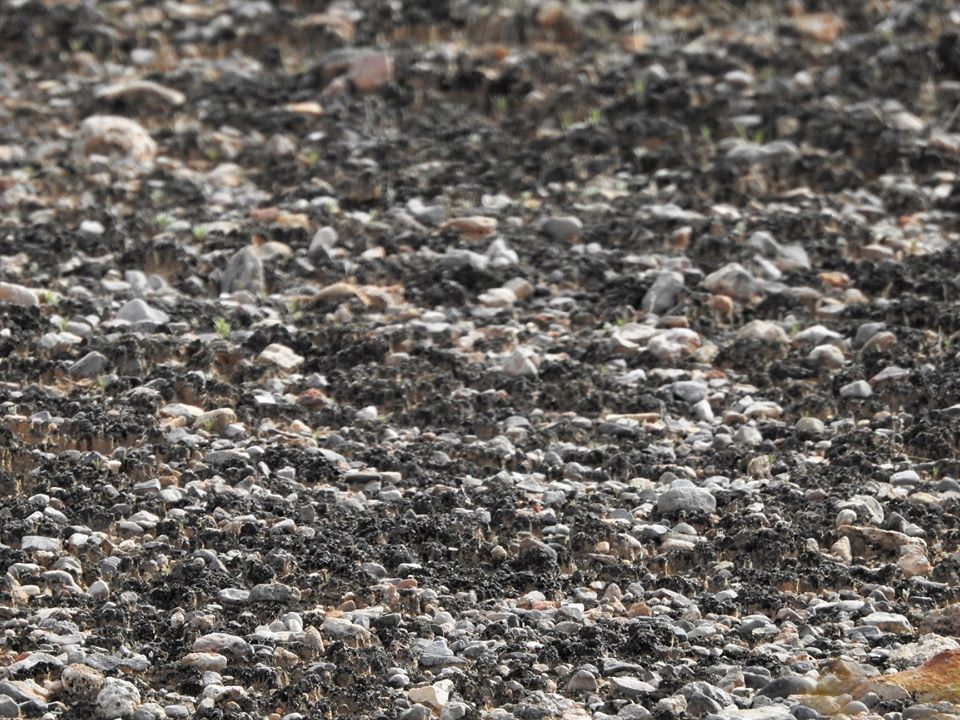
^Detail of the micro-forest of Biologcial Soil Crust, living non-vascular plants.
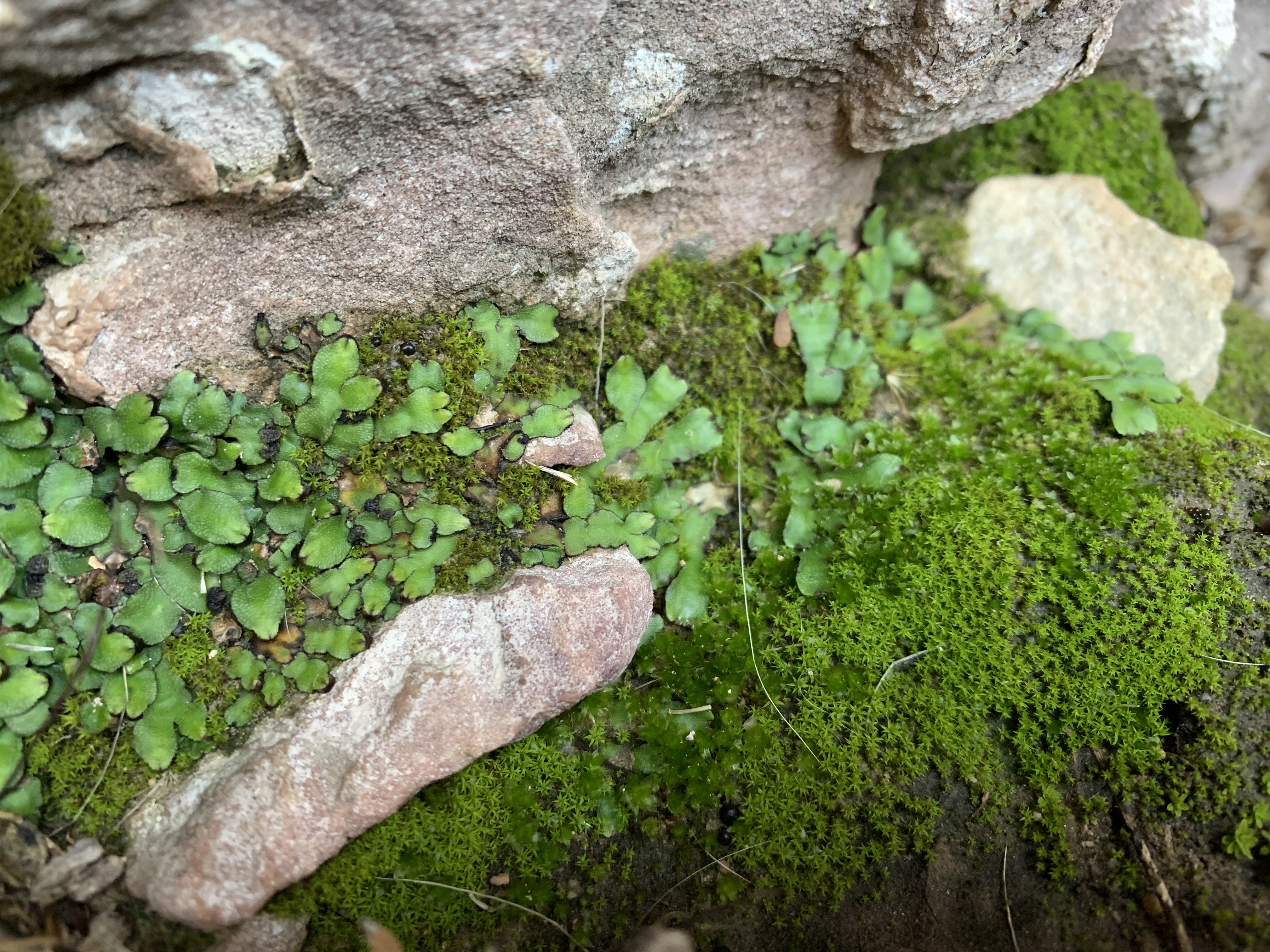
^Greened-up Biological Soil Crust in a moist rock shelter, after rains: mosses and liverworts are lush.

^Liverworts come to life with rains.
Layne's milkvetch (Astragalus layneae), along with Indian rice grass (Stipa hymenoides).
^Layne's milkvetch, a common wildflower. We were searching for the rare threecorner milkvetch (A. geyeri var. triquetrus) but did not find it.
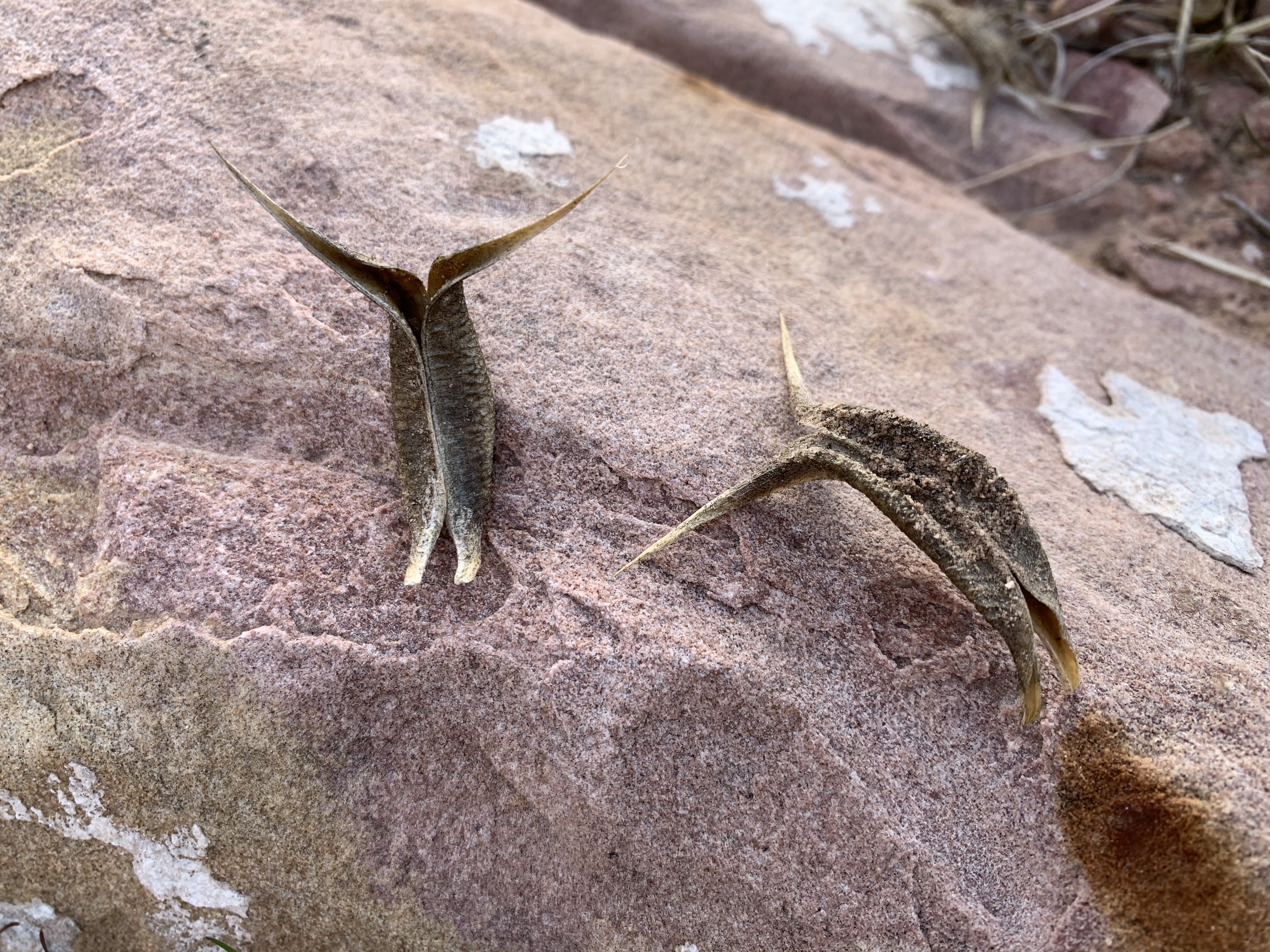
^Strange alien dried seedpods of Layne's milkvetch, split open from last year.
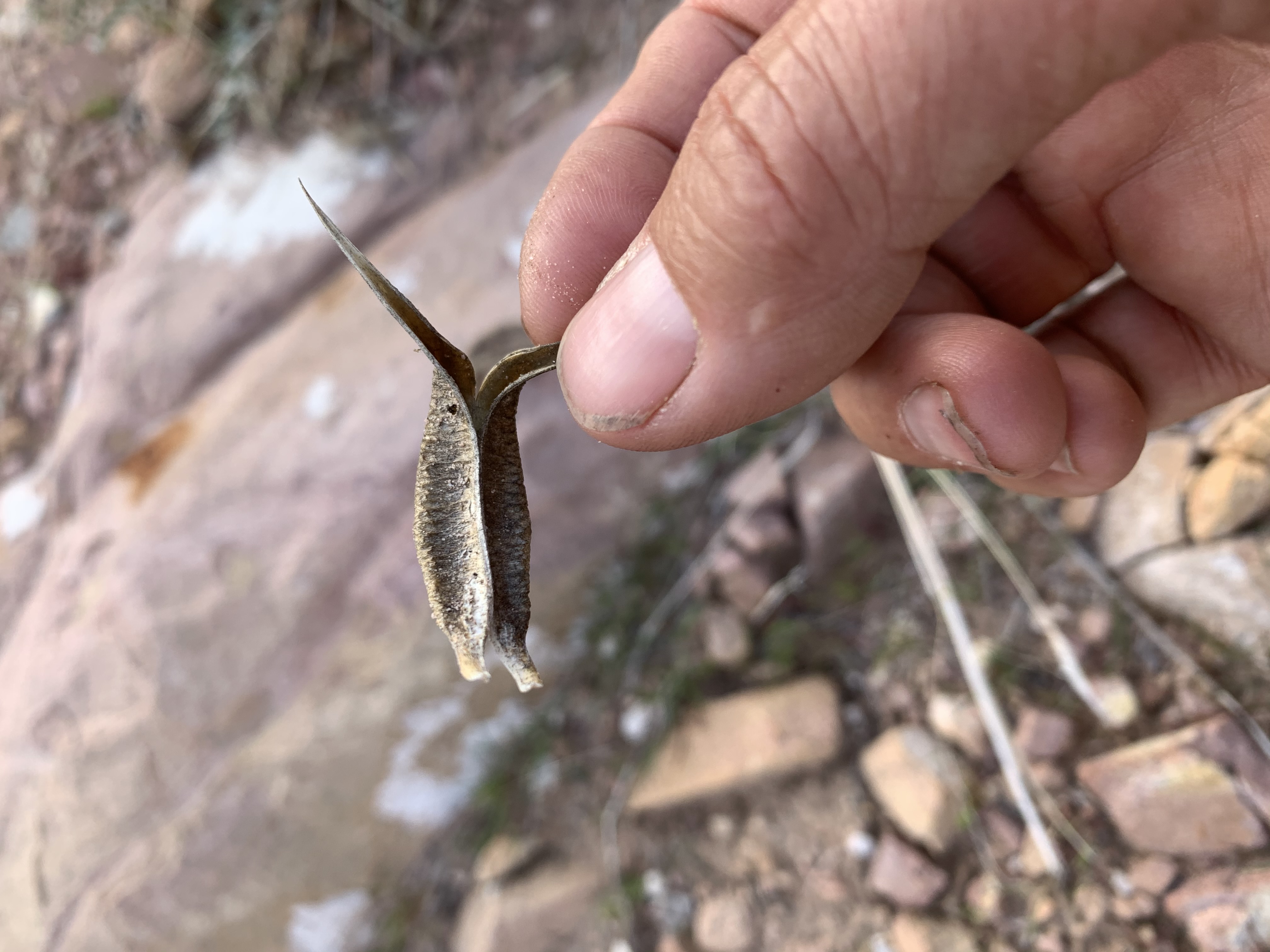
^Dried split open seedpod of last-year's Layne's milkvetch.
^Dark-colored Biological Soil Crust in a stand of big galleta grass (Hilaria rigida).
^The view across the proposed Gemini Solar Project on pristine undisturbed Mojave Desert on California Wash, where the historic Old Spanish Trail crosses. Sheep Range in the distance.
^Muddy Mountains from California Wash.
^Snowy peaks of the Sheep Range visible from the Gemini Solar Project proposed site.
^Beavertail cactus (Opuntia basilaris).
^Silver cholla (Cylindropuntia echinocarpa). The solar project will paryially be "mowed" down to 18 inches. This cholla was 3 feet tall.
^Desert almond (Prunus fasciculata) are tall shrubs to 4 feet, along sand washes through the proposed project site. Will these be mowed?
^Color Rocks in the adjacent Muddy Mountains Wilderness Area.
^Indian rice grass.
Final Environmental Impact Statement Out
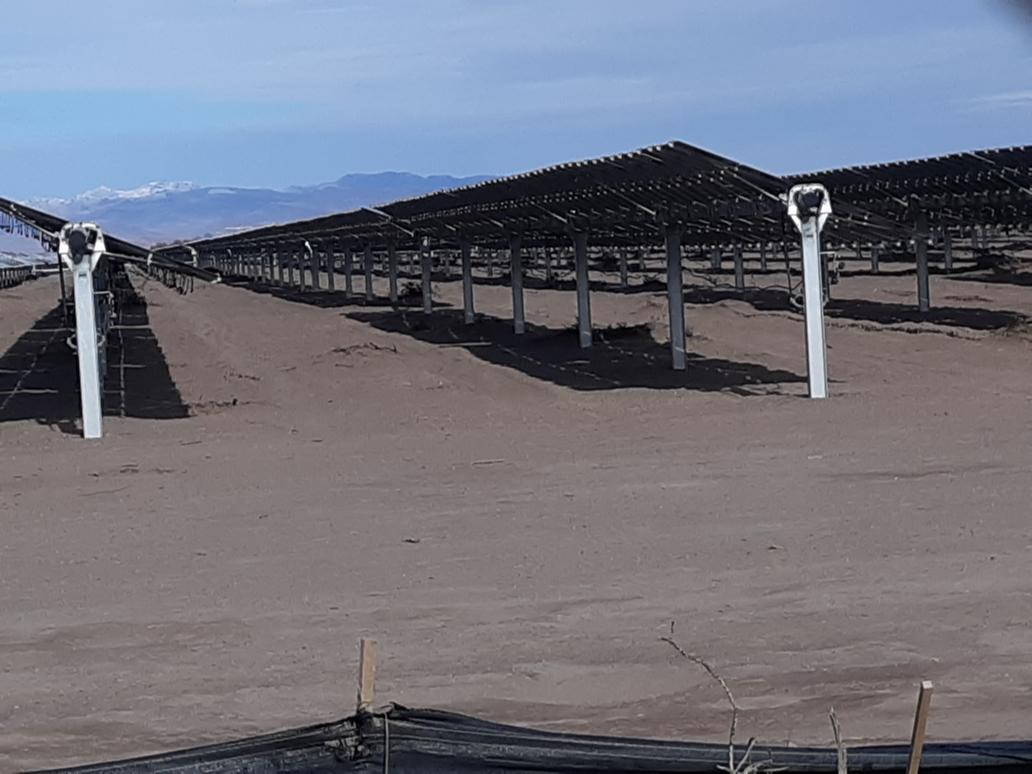
^"Mowed" creosote-bursage Mojave Desert vegeation at Sunshine Valley Solar Project just completed and in operation, Amargosa Valley, Nevada. This stripping and crushing of desert vegeation is not better than traditional methods of scraping and grading, and should not be considered as a "better way." December 2019. Will this be what Gemini Solar Project "mowed" solar project units look like? Rare milkvetches will not survive the trampling, crushing, truck traffic, construction machinery, heavy equipment, and 100% soil disturbance of this proposed project.
December 30, 2019 - Clark County Mojave Desert NV - The Bureau of Land Management (BLM) has published a Notice of Availability in the Federal Register for the Proposed Resource Management Plan Amendment and Final Environmental Impact Statement analyzing the environmental impacts of the proposed Gemini Solar Project, to be located on BLM-administered land northeast of Las Vegas. If approved, the project would generate up to 690 megawatts of electricity but greatly impact the federally threatened Mojave desert tortoise.
Solar Partners, XI LLC (Arevia) proposes to construct, operate and eventually decommission the Gemini Solar Project, which consists of an approximately 690-megawatt alternating current solar photovoltaic power generating facility on roughly 7,100 acres of BLM administered land located about 33 miles northeast of Las Vegas and directly south of the Moapa River Indian Reservation. The Notice of Availability opens a 30-day protest period that will end on January 27, 2020.
The Hybrid (BLM Preferred) Alternative would involve solar development utilizing a combination of traditional development methods in solar array areas (scraping and grading the delicate biological soil crusts, creosote-bursage shrublands, big galleta grass patches, and desert willow/catclaw acacia microphyll woodlands on roughly 2,500 acres), and mowing on the remaining solar array areas (on approximately 4,600 acres). Mowing is a controversial method that still crushes and disturbes delicate soils and Mojave Desert vegetation, as well as crushing burrows and creating clouds of dust.
Associated Press mentions Basin and Range Watch such as in the Las Vegas Sun, about this project.
Protests will be accepted from any person who participated in the planning process and has an interest which is or may be adversely affected by the approval or amendment of a resource management plan may protest such approval or amendment. A protest may raise only those issues which were submitted for the record during the planning process. The protest shall be in writing and shall be filed with the Director. The protest shall contain: (i) The name, mailing address, telephone number and interest of the person filing the protest; (ii) A statement of the issue or issues being protested; (iii) A statement of the part or parts of the plan or amendment being protested; (iv) A copy of all documents addressing the issue or issues that were submitted during the planning process by the protesting party or an indication of the date the issue or issues were discussed for the record; and (v) A concise statement explaining why the State Director's decision is believed to be wrong. The BLM will issue a Record of Decision approximately within 90 days after the publication of the Notice of Availability of the FEIS. The Record of Decision will be also be announced in a Notice of Availability in the Federal Register.
The FEIS and other relevant documents have been made available at https://go.usa.gov/xntTQ.
Protests must be in writing and mailed to one of the following addresses:
Regular mail: Director (210), Attn: Protest Coordinator, P.O. Box 71383, Washington, D.C. 20024-1383
Overnight delivery: Director (210), Attn: Protest Coordinator, 20 M Street SE, Room 2134LM, Washington, DC 20003
For more information, please contact, Nicholas Pay, Acting Energy & Infrastructure Project Manager, at 702-515-5284.
From the BLM press release: https://www.blm.gov/press-release/bureau-land-management-releases-final-environmental-impact-statement-proposed-gemini-0
US Fish and Wildlife Service Details Impacts to Desert Tortoise from Gemini Solar Project
^We found this large tortoise burrow on the proposed project footprint in October, 2019.
November 13, 2019 - The U. S. Fish and Wildlife Service sent us, upon request, the biological opinion for the large-scale Gemini Solar Project in northeastern Clark County, Nevada, which would impact the federally threatened Mojave desert tortoise (Gopherus agassizii) in accordance with section 7 of the Endangered Species Act of 1973. Analyzing this biological opinion, we see a slippery slope to extinction for the tortoise, however.
Desert Tortoise
The proposed Project will permanently impact approximately 4,511 acres of high-quality desert tortoise habitat and contribute towards the combined negative effects to the 47,420-acre recipient areas (short-distance and distant) as a result of translocation of all project tortoises. In other words, moving tortoises into the surrounding desert already occuppied by tortoises will result in increased competition, and mortality as tortoises seek new burrows for cover from heat and predators.
The biological opinion admits that death and injury of desert tortoises could result from excavation activities such as clearing and grubbing of vegetation; trenching activities and entrapment in open trenches and pipes; and collisions with or crushing by vehicles or heavy equipment, including individuals that take shelter under parked vehicles and are killed or injured when vehicles are moved. Desert tortoises that enter or attempt to cross project access roads may be struck resulting in death or injury. Mortality mechanisms also include individual desert tortoises or their eggs being crushed or buried in burrows during construction and operating and maintenance activities. Because of increased human presence in the area, desert tortoises may be killed or injured due to collection or vandalism associated with increased encounters with workers, visitors, or unauthorized pets. Desert tortoises also may be attracted to the construction area by application of water to control dust, placing them at higher risk of death or injury.
Because 65 percent of the solar site will be enclosed with permeable fencing and most vegetation would be maintained on site during operations, it is likely that tortoises would pass through these portions of the solar site and reoccupy it so some extent, though the extent to which tortoise would reoccupy these areas is unknown at this time. The presence of desert tortoises on the solar site may result in injuries or death during routine maintenance of facilities. Tortoises outside of the fenced solar site may also be injured or killed due to truck traffic along the gen-tie line and associated access roads. This is all an experiment, and we have no idea how many tortoises will die.
The U. S. Fish and Wildlife Service estimated that all life stages of desert tortoise that occur within the direct effects action area may be adversely affected by the proposed action.
They acknowledged that not all individuals killed or injured during construction and operation activities will be detected by biologists, biological monitors, or project staff and subsequently reported to the Service. The inability to detect all tortoises is largely due to the cryptic nature of desert tortoises, fossorial habits, and limited abundance. In the case of juveniles and eggs, their small size and location underground reduce detection probabilities of these life stages. Another confounding factor is that scavengers may locate, consume, or remove carcasses before monitors can locate them.
Vibration will be caused by heavy equipment (e.g., bulldozers and backhoes) that would cause surface disturbance and otherwise operate during construction would be needed to construct access roads, the O&M building, and the proposed electric substation; to install solar arrays and poles; and to trench for installation of cable and wiring. A few areas that are just outside of the action area may experience short-term or temporary vibrations that could potentially disturb desert tortoises.
Burrows within 50 feet of the fence at the time of activity could be impacted by vibration. Blasting during construction would also produce vibration. Ground vibrations could cause stress to tortoises, which may result in avoidance of the area, thereby increasing the risk of mortality from increased temperatures or predators.
Mowing would substantially modify the habitat, due to the mowed and crushed vegetation and the presence of solar arrays and roads. Burrows would be maintained in the mowed area where possible. The areas constructed using traditional methods would represent a permanent loss.
Construction activities and operational vehicle traffic on the roads within the action area could generatelarge amounts of dust that could affect vegetation adjacent to and within the action area during construction.
Construction activities would require the use of over a hundred pieces of equipment. Noise levels at 50 feet from the two loudest equipment types for each construction activity, representing a conservative noise level, are expected to be between 68 and 85 decibels. Desert tortoises outside of the proposed solar facility boundary may experience intermittent exposure to increased noise levels. Increased noise levels may affect desert tortoise foraging and sheltering behavior, leading to poor health and increased risk of mortality, during construction and operations of the facility over a 30-year period. Desert tortoises haverelatively sensitive hearing (i.e., mean = 34 dB SPL).
New Gen-tie lines and transmission will create perches for ravens and other predators, including a new 500 kilo-Volt giant transmission line with tall towers.
Mowing would substantially modify the habitat, due to the mowed and crushed vegetation and the presence of solar arrays and roads. Total long-term disturbance from traditional methods of construction using grading and total desert removal within occupied desert tortoise habitat from the Project would be approximately 2,602 acres. This acreage would be permanently fenced to exclude desert tortoise and would be considered a permanent loss of habitat for the species.
The remaining 4,460 acres of mowed vegetation could be considered "semi-permanently disturbed," as this acreage is permanently altered due to the installation and operation of the solar facility; however, vegetation would recover to some extent (and will be monitored), but many invasive annuals will replace native plants.
Because recovery of vegetation in the desert can take decades or longer, we consider all ground-disturbing impacts associated with the proposed project to be long-term. The biological opinion quotes several refences, including Webb (2002) who determined that absent active restoration following extensive disturbance and compaction in the Mojave Desert, soils in this environment could take between 92 and 124 years to recover. Other studies have shown that recovery of plant cover and biomass in the Mojave Desert could require 50 to 300 years in the absence of restoration efforts (Lovich and Bainbridge 1999). Based on a quantitative review of studies evaluating post-disturbance plant recovery and success in the Mojave and Sonoran deserts, Abella (2010) found that reestablishment of perennial shrub cover (to amounts found on undisturbed areas) generally occurs within 100 years but no fewer than 40 years in some situations.
The impact of the proposed project on the desert tortoise will be huge, with changes in species composition and fire regimes due to establishment of nonnative plant species, existing and increasing disease and predation rates, and the expansion of human occupancy in what were once remote desert landscapes.
Capture and translocation of desert tortoises may result in accidental death and injury from stress or disease transmission associated with handling tortoises, stress associated with moving individuals outside of their established home range, stress associated with artificially increasing the density of tortoises in an area and thereby increasing competition for resources, and disease transmission between and among translocated and resident desert tortoises. Capture and handling of translocated and resident desert tortoises for the purposes of conducting health assessments, which include visual inspection relative to body condition, clinical signs of disease, and collection of biological samples for disease screening (i.e., blood samples to test for antibodies to pathogens), could result in accidental death or injury.
Translocation has the potential to increase the prevalence of diseases, such as URDT, in translocated and resident desert tortoises. Physiological stresses associated with handling and movement or from density-dependent effects could exacerbate this risk in translocated individuals with subclinical URTD or other diseases that present symptoms subsequent to translocation.
Desert tortoises in quarantine pens could increase their exposure and vulnerability to stress, dehydration, and inadequate food resources. However, because desert tortoises will be monitored regularly, care will be administered following specific procedures, and the quarantine period should not exceed one year, we anticipate that quarantined individuals are unlikely to experience death or injury from the vulnerabilities identified above. The potential exists, however, for predators or poachers to target quarantined desert tortoises. This risk also is expected to be minimized through regularly scheduled monitoring in accordance with the desert tortoise translocation plan.
Because ELISA testing can yield false-positive results (i.e., an animal may test positive even though it is not a carrier of the disease), the removal of healthy individuals from the translocated population may occur due to concern over disease. These individuals would be removed from the wild and, thereby, no longer contribute to the environmental baseline for the action area. Removing these individuals may inadvertently reduce the resistance of the population to disease outbreaks.
Boarman (2002), in a review of literature on threats to the desert tortoise, stated that the adverse effects of translocating desert tortoises include increased risk of mortality, spread of disease, and reduced reproductive success. Translocated desert tortoises have a tendency, at least initially, to spend more time aboveground moving through their environment than animals within their home ranges; this tendency exacerbates at least some of these threats.
Field et al. (2007), Nussear (2004), and Nussear et al. (2012) have conducted studies focused on translocating desert tortoises and found that translocated animals seem to reduce movement distances following their first post-translocation brumation to a level that is not significantly different from resident populations.
Regardless of the distance desert tortoises would be moved, the Fish and Wildlife Service expect that animals that are moved from the project sites would spend more time aboveground and moving, at least during the first year, which means they would be more vulnerable to predators, adverse interactions with other desert tortoises, and weather conditions than resident or control animals. During this first year of increased movement, desert tortoises would also be more likely to engage in fence pacing behavior, which can lead to hyperthermia and death.

In spring 2009, 570 tortoises were translocated from the United States Army National Training Center at Fort Irwin in California south of the project boundary. Genotypes were determined for the translocated male tortoises and an additional 190 resident male tortoises (Mulder et al. 2017). In 2012, 96 female tortoises (50 resident and 46 translocated) were tracked, and nests were visited until blood samples were taken from all live hatchlings (97 hatchlings from 36 nests) and genotyped. The paternity was determined for 35 hatchlings, and all 35 hatchlings were found to be offspring of resident males, with translocated males producing no offspring (Mulder et al. 2017).
Translocation also affects resident desert tortoises within the maximum dispersal area due to local increases in population densities. Desert tortoises from the solar facility site would be moved to areas now supporting a resident population, which may result in increased interspecific encounters and, thereby, an increased potential for spread of disease, potentially reducing the health of the overall population; increased competition for shelter sites and other limited resources; increased competition for forage, especially during drought years; and increased incidence of aggressive interactions between individuals (Saethre et al. 2003).
There is currently one ongoing study of a solar site that left vegetation within the facility and allowed tortoises access to the site. The Valley Electric Association constructed a solar project on 80 acres in Pahrump, Nevada. Vegetation onsite was mowed and crushed while solar panels were installed. Four tortoises were held in pens during construction, affixed with transmitters, and released back into the solar site in October 2017. Monitoring reports to the Service have documented that two of these tortoises, a female and male, have been found within and around the solar site since construction. In 2019, the female was found within the facility nine times and the male was located within the facility once. The vegetation in the facility has rebounded from being crushed, and the tortoises appear to be using the site as habitat. While this project is small in scale in comparison to the 65 percent of the proposed Project, we believe it is likely that tortoises placed back into the solar site will utilize the site to some extent. We are uncertain whether tortoises will use the site immediately upon release or after the vegetation has rebounded. There is also a chance that tortoises placed back into the mowed site will move out of the site after release.
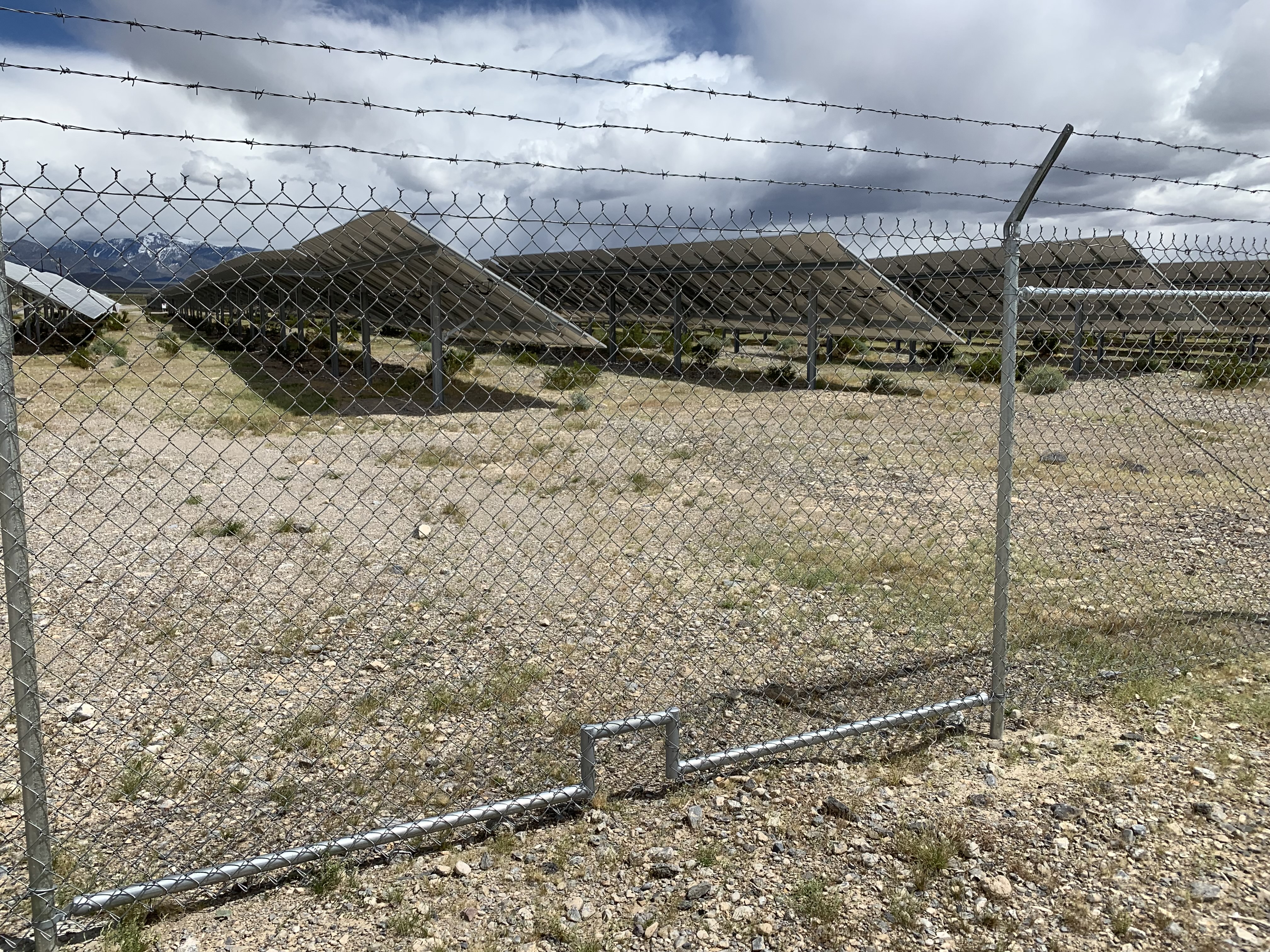
^Valley Electric Association experimental solar project in Pahrump Valley, which allows tortoises to enter the disturbed ground with mowed vegetation under the solar panels.
Fish and Wildlife Service expects that the construction of the Project (solar facility and gen-tie lines) is likely to injure or kill adult desert tortoises. Many more tortoises are likely to be captured and moved prior to project activities. Based on tortoise surveys and a 25 percent buffer, we estimate that 274 adult tortoises and 1,802 juvenile tortoises may experience some type of take. Although we expect most to be captured and moved, some may be injured or killed.
Take: Death or injury of adults and subadults in the solar field is 15
Death or injury of adults and subadults outside the solar field – 8
Death or injury- hatchlings & juveniles (<180 mm) inside and outside solar fields – 1,802
Capture- subadults & adults (≥180 mm) – 794
Capture- hatchling & juveniles (<180 mm) – 2,700
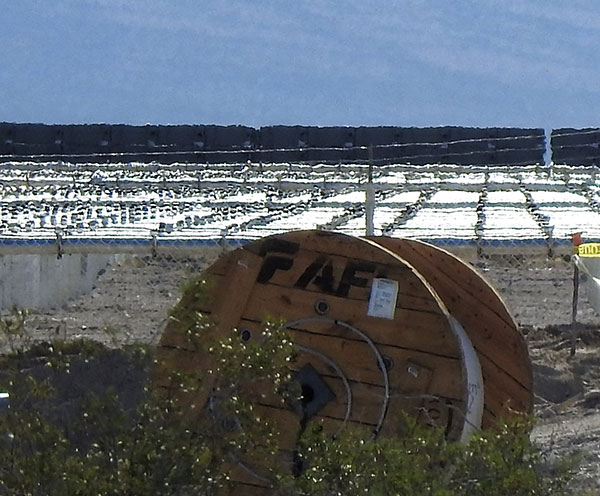
^Mowed creosote in the Mojave Desert under Sunshine Valley Solar Project in Amargosa Valley, Nevada.
The mitigation measures on this project are being minimized as to their effectiveness, for a species that is already in a crisis of decline.
The Fish and Wildlife Service considers the mowing alternative as viable. We do not. They measure the connectivity corridor pinch point based on the bulldozed footprint and assume that the mowed footprint will continue to provide viable habitat. This is an important connectivity corridor linking critical habitat units, that is rapidly being filled up with utility-scale solar projects such as the ones at Apex, the solar project on the Moapa Paiute lands, and now this proposed massive Geminisolar project.
Avian-Solar Problems Unaddressed
The proposed project may affect the endangered Yuma clapper rail (Rallus obsoletus yumanensis), endangered southwestern willow flycatcher (Empidonax traillii extimus), or threatened yellow-billed cuckoo (Coccyzus americanus).
There are documented records of all three species in suitable habitat within 15 to 20 miles of the project: Ash Meadows National Wildlife Refuge, Overton Wildlife Management Area, Las Vegas Wash, Warm Springs Natural Area, and Pahranagat National Wildlife Refuge. Migration and dispersal of birds is too-little studied, and the "lake effect" of solar projects attracting birds has already been documented across the desert. Two mortalities of Yuma clapper rails and one yellow-billed cuckoo at solar facilities in California have been documented. Birds see a reflective surface and try to land, either crashing on the panels, or landing and perhaps becoming disoriented and dyhydrated. These avian-solar mortality issues are completely unaddressed in the biological opinion.
Rare Plants
Rare plants such as the threecorner milkvetch and Nyw milkvetch are found on the proposed project site. Threecorner milkvetch is considered "critically endangered" by the state of Nevada, although no rare plants in this area are actually federally listed (yet). Basin and Range watch has petitioned the U. S. Fish and Wildlife service to list the threecorner milkvetch as endangered under the Endangered Species Act.
The project applicants are proposing to use a new herbicide that will specifically kill milkvetches. This is completely unacceptable, and a futther threat to the rare plants aside from habitat removal and disturbance.
Gemini Solar Project Applicant Seeking Fast-Track Outside of Public Review
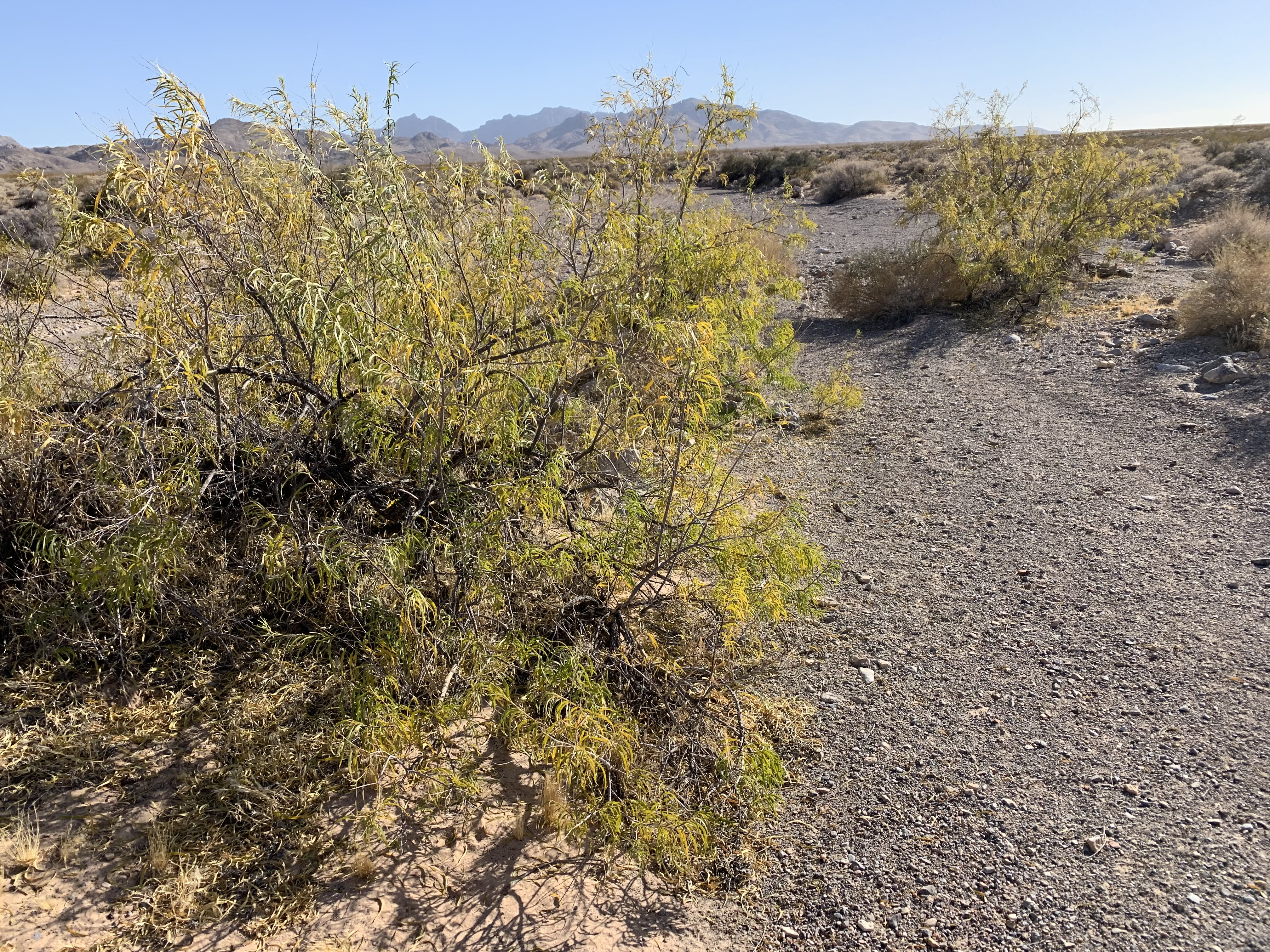
^Wash with desert willows turning fall colors, in the project footprint. These would be cut down to a few feet in height and built over with solar panels.
October 18, 2019 - Clark County NV - Basin and Range Watch put pressure on the Nevada state office of Bureau of Land Management (BLM) to not allow the company seeking to build the 11-square-mile photovoltaic solar project on public lands from placing more meteorological towers and road construction before the project is approved. The project is currently undergoing environmental review.
The Mojave Desert here has many sensitive resources, including rare plants, a dense desert tortoise population, sand habitats, microphyll scrub communities, desert washes, and the Old Spanish Trail. We saw a Crissal thrasher run across one sandy wash lined with catclaw acacias and desert willows--both turning fall colors.
Arevia, trying to get much-needed tax breaks, tried to rush building roads, MET towers, and grading on a portion of the project in order to fulfill terms of the tax incentive by a certain deadline. But BLM pushed back (with nudging from us), that this would be illegal under the National Environmental Policy Act (NEPA). BLM issued this letter, a part of which is shown below.
On a field trip in October 2019, the desert holds many secrets:
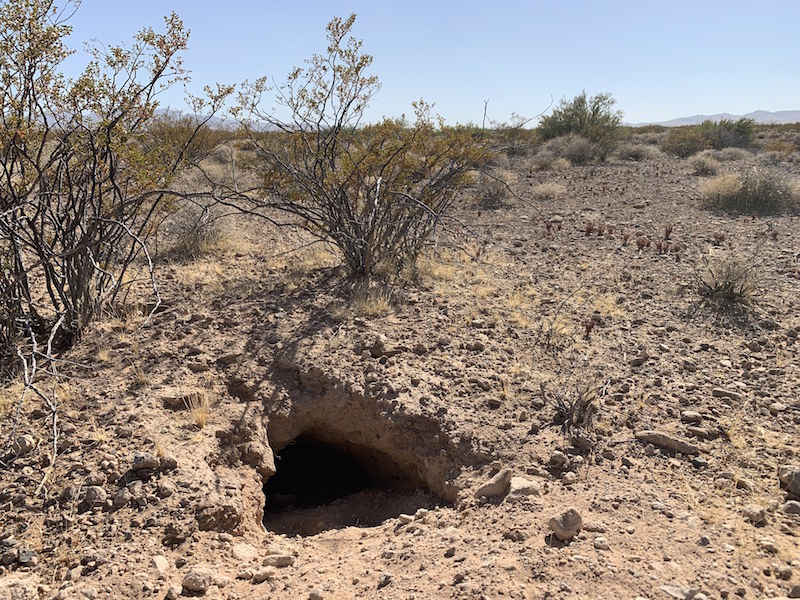
^Beautiful example of a desert tortoise burrow on the project site. These burrows will be dug out and any tortoises moved to another location--many die during the translocation process.
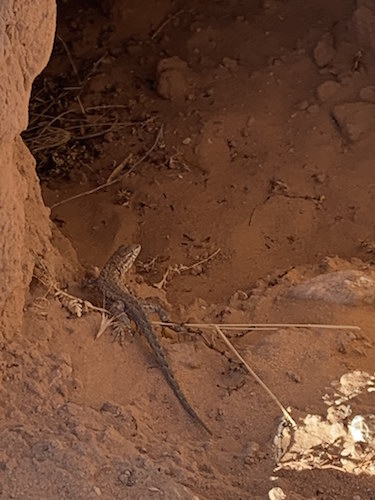
^A side-blotched lizard in a kit fox burrow. These burrows will be likely crsuhed and collapsed by heavy machinery.
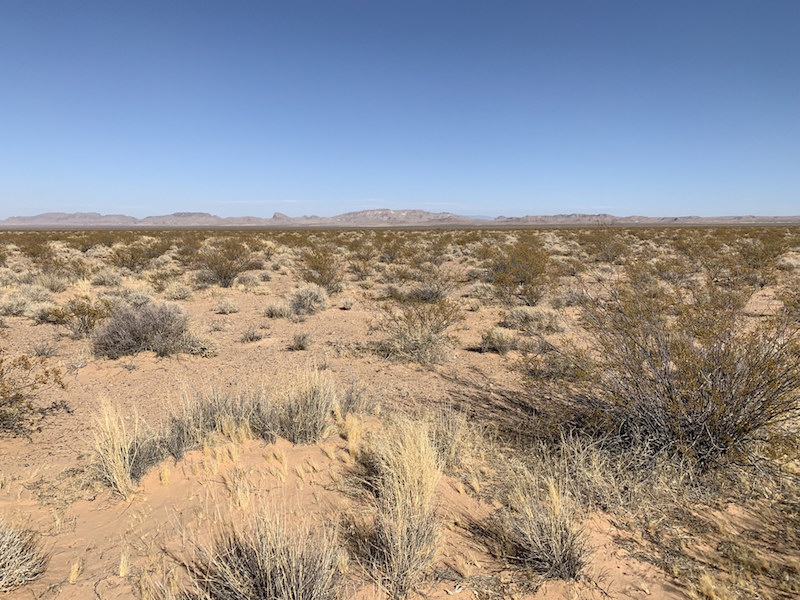
^The Gemini Solar Project site, with ricegrass, big galleta, and creosote.
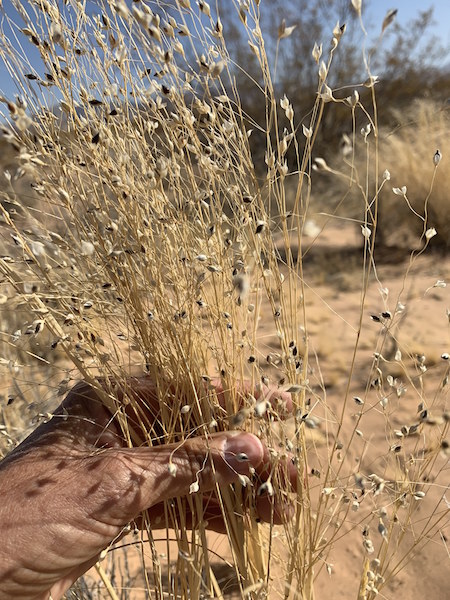
^Native ricegrass seedheads. This grass is common across the project and will be mowed and driven over repeatedly by heavy machinery.
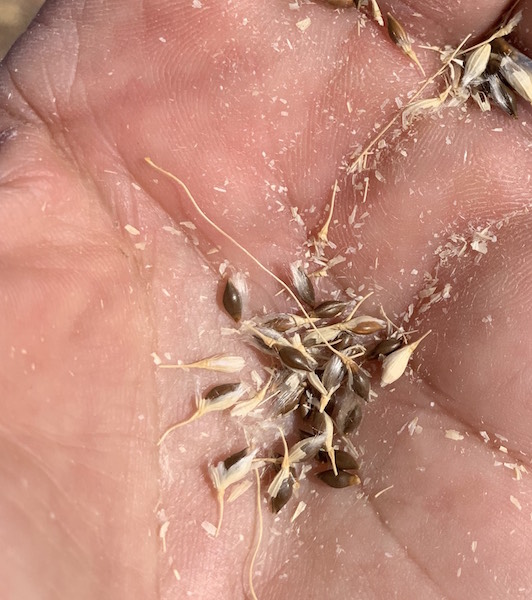
^Ricegrass seeds ripe and ready to grind into flower. The solar project will be bulldozing food.
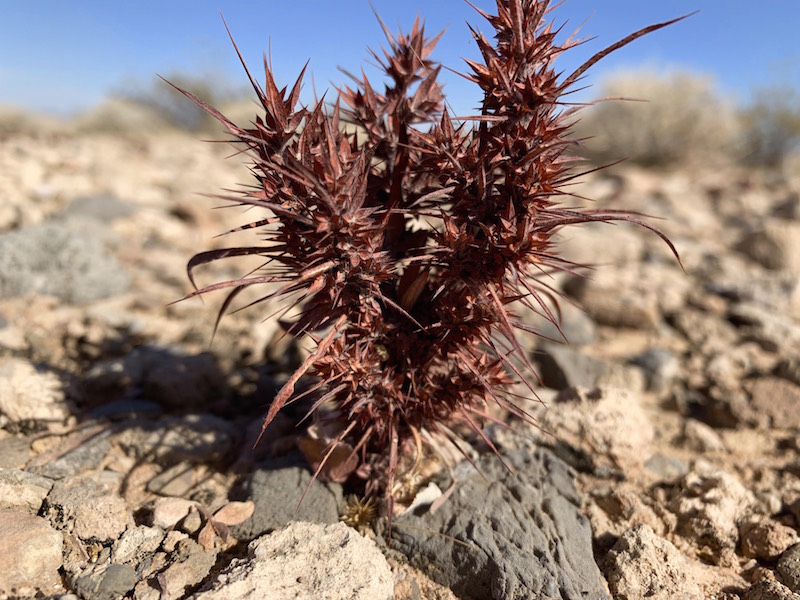
^Spineflower (Chorizanthe rigida) dry and reddish after a spring bloom.
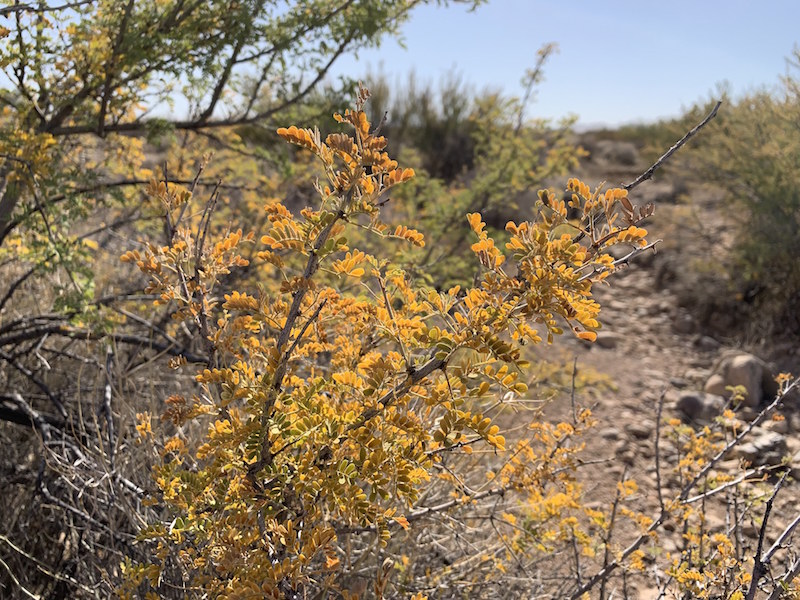
^Catclaw acaia turning fall colors. These microphyll shrubs will be masticated by machines in order to build the solar project.
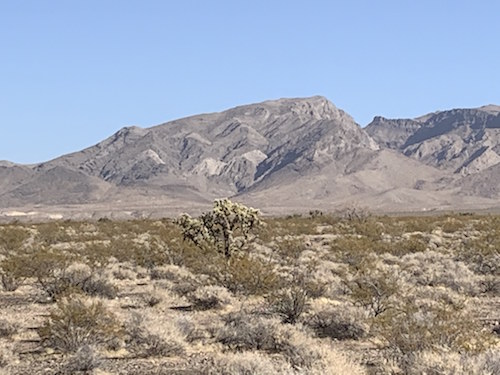
^Silver cholla and the Mormon Mountains Wilderness.
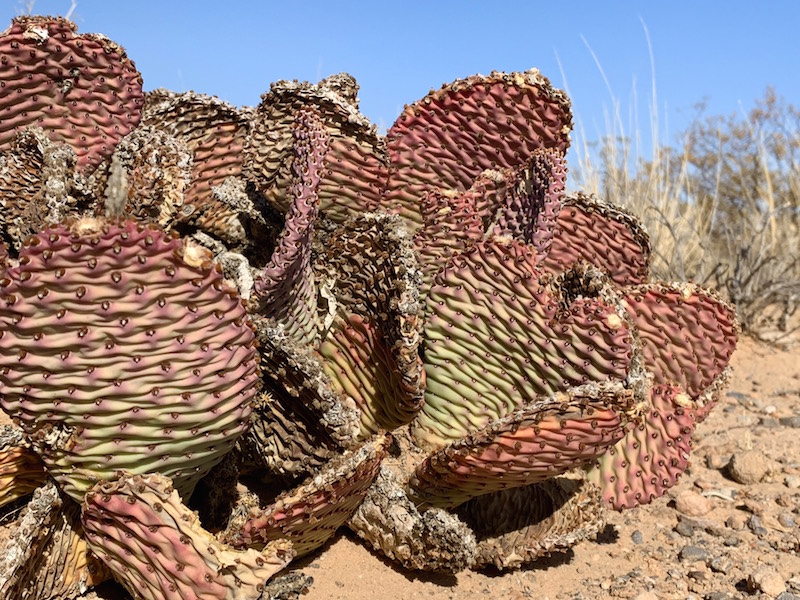
^Beavertail cactus turning reddish after a dry summer.

^Ventifacts are common here, limestone carved by sandblasting. What will this do to the glass on the solar panels over time? The built envieonmrnet is a much better alternative to plave solar panels.
The Swamp is Alive and Well in Nevada
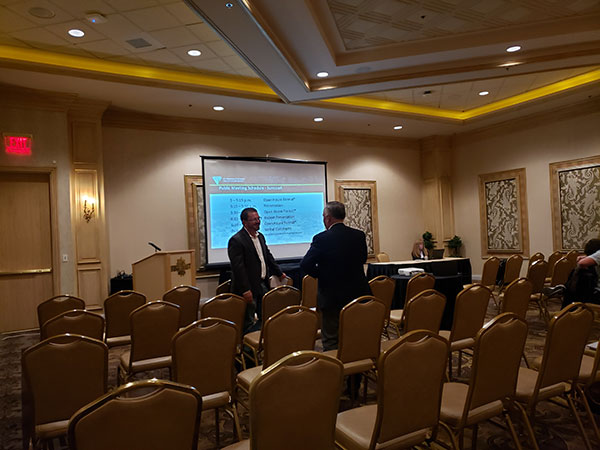
July 27, 2019 - Las Vegas, NV - At one of the public meetings for the Gemini Solar Project, we met Nevada State Senator Chris Brooks. But he quickly told us that he was just Chris Brooks that night and not Senator Brooks. That is because he owns a company called Brooks Consulting and told us he has a personal involvement with Gemini Solar. Gemini Solar received a Power Purchase Agreement with NV Energy in late June. As Senator Brooks, he introduced the 50 Percent Nevada Renewable Portfolio Standard bill for Nevada which passed in March and was signed into law. This requires Nevada utilities to acquire 50 percent of their energy from Renewable sources by 2030. How interesting that a solar project he is involved in is the first to profit off the 50 percent RPS legislation.
Gemini Solar Project is owned by Quinbrook Infrastructure Partners' Low Carbon Power Fund. But what is not factored into this investment in renewable energy is that the project that will have long-term environmental issues and is not needed in this location to fight climate change. The significant harm to the Mojave Desert ecosystem here, desert tortoises, rare plants, recreation, and carbon storage in the desert soils and vegetation is not being valued. A few will profit, and our public lands will be degraded and closed off here.

^The federally threatened Mojave desert tortoise continues to decline.
Arevia Power and the Bureau of Land Management (BLM) claim that mowing vegetation – as opposed to using traditional bulldozing and grading methods – on the site of its proposed Gemini Solar Project northeast of Las Vegas will allow the solar project site to double as suitable tortoise habitat. Biologists and botanists familiar with tortoise habitat requirements and the likely impacts of construction on the tortoise’s primary food sources assess that the company’s and BLM’s claims are wrong and underestimate the project’s impacts on wildlife.
The BLM is seeking public comment on a plan to build the Gemini Solar project across 11 square miles of desert habitat just outside of Valley of Fire State Park. The plans call for using an unproven mowing technique on seven square miles of the project site, and the traditional “disc and roll” clearing of the desert on the remaining four square miles. The BLM’s environmental analysis claims that the company will be able to reintroduce desert tortoises to the mowed area once the solar panels have been installed.
In order to mow the vegetation across seven square miles, the company would use heavy equipment to cut existing vegetation down to 18 inches. The BLM’s environmental analysis acknowledges that this process will also result in desert plants being crushed by heavy equipment. Crews will then pound in thousands of steel posts with pile-drivers that will hold panels, and use ditch diggers to install collector lines all across the site. Miles of new access roads and utility corridors would also have to be constructed.
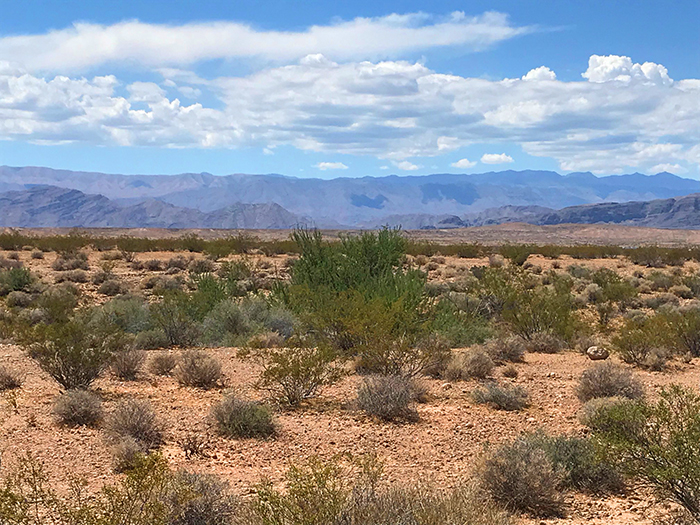
^This is the proposed Gemini Solar Site, which includes croesote, bursage, and washes with catclaw acacia and desert willow.
The ground disturbing activities that Arevia Power proposes also bring another risk – the proliferation of nonnative weeds that outcompete native plants. Weeds such as red brome and cheatgrass provide little or no nutrients to tortoises, but they can spread rapidly across soils disturbed by construction activities. The BLM’s environmental analysis proposes weed management activities that involve spraying herbicide across the project site, but that will require more trampling of desert plants and compaction of soils, leading to a cycle of habitat degradation. Also, herbicides can kill off beneficial native plants.
The Gemini Solar project is expected to displace as many as 260 desert tortoises, and also impact one of the few remaining populations of the threecorner milkvetch, a desert plant listed as critically imperiled in Nevada. Tortoises that are relocated to neighboring habitat often face an uphill battle for survival, removed from their network of burrows. At the nearby Moapa Solar power project, ten tortoises died within a year of being displaced, according to the U.S. Fish and Wildlife Service. A study by the Smithsonian Conservation Biology Institute also found that relocated tortoises reproduce at a significantly lower rate.
The new questionable idea is to now take down the fences surrounding the solar fields after a while, and let tortoises re-enter the construction site. A board member of the Desert Tortoise Council was at the meeting, and told us they are looking for a way to build utility-scale solar projects without blocking tortoise connectivity across the landscape. But instead of scientifically testing and collecting evidence on the efficacy of smaller projects that mow desert vegetation and allow tortoises to re-enter--such as the Pahrump Valley Solar Project--the agencies are forging ahead with a giagantic experiment to mow thousands of acres of Mojave Desert Scrub and microphyll woodland, and see if tortoises do not suffer high mortality. Unfortunately the Desert Tortoise Council and many environmental organizations support this blind experiment on a large scale.
The area around the project site has a high density of tortoises. BLM says that the success of reintroduction to mowed areas is unknown. US Fish and Wildlife Service guidance does not allow short-distance translocation into higher tortoise density sites. Contradictions and questions abound with this project.
The latest plan is to translocate one of four big clusters of tortoises to he old desert tortoise conservation center in Las Vegas and hold them there for one year. When the vegetation grows back at the project site, the fence will be removed and the tortoises will be released back on the site. This is quite a lot of new transportation for these reptiles.
Also, the mowed alternative seems to now be the "reduced acreage" alternative. This is not a viable alternative since it appears to be experimental, and no one knows if the mowed project is going to provide viable habitat.

^A telephoto lens captues the mowed desert underneath thousands of reflective photovoltaic panels on Sunshine Valley Solar Project, under construction in Amargosa Valley, Nevada. The tall creosote shrub in the foreground used to cover the valley floor here, but was mowed, then posts pile-drived into the ground to mount solar panels on. This is a huge disturbance to the native Mojave Desert ecosystem.
We have to roll out solar energy without exacerbating the extinction crisis, and use much more renewable energy in already disturbed areas and in the built environment.
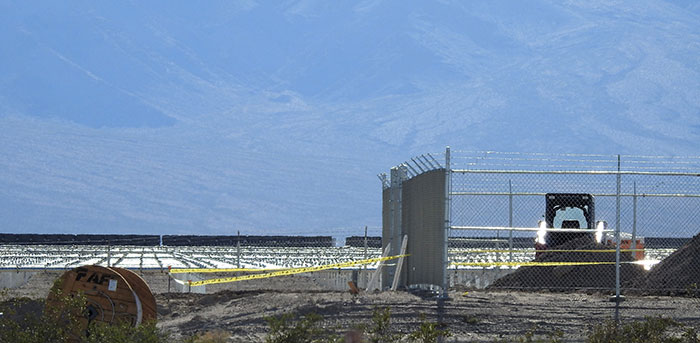
^Sunshine Valley Solar Project under construction, with mowed vegetation.
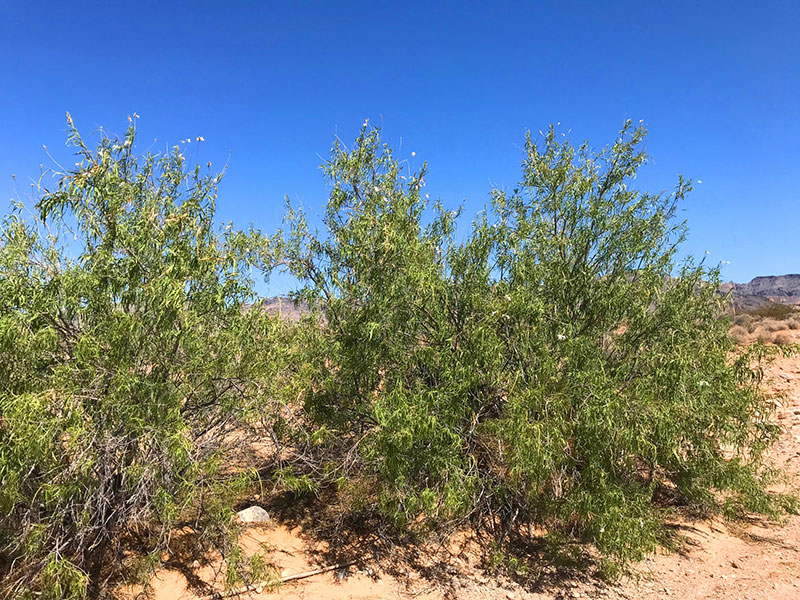
^Desert willows on the Gemini site--will these trees be mowed too?
Public Meetings for Gemini Solar Project
July 21, 2019 - Public Meeting #1 - Las Vegas
When: Tuesday, July 23rd, 5:00 - 8:00 PM
Where: Suncoast Hotel and Casino, 9090 Alta Dr, Las Vegas, NV 89145
Public Meeting #2 - Moapa
When: Wednesday, July 24th, 5:30 - 8:30 PM
Where: Moapa Community Center, 1340 East State Highway 168, Moapa, NV 89025
Thank you to our colleague at Mojave Desert Blog for posting about this ill-sited project. An excerpt:
Mowing or Bulldozing?
Perhaps the most absurd aspect of the Gemini Solar project proposal is that the company promises to reduce impacts on wildlife by mowing vegetation on part of the site. This proposal is a public relations stunt, not a scientifically sound method to preserve habitat. Of the 11 square miles that Arevia Power plans to use for the Gemini Solar project, 7 square miles will be mowed and the remaining 4 square miles will be bulldozed. Plants could be mowed down to 18 or 24 inches, according to the BLM's environmental analysis, and that would require tractors driving across much of the site. This means that not only will plants be cut down or crushed by the vehicles, the soils will be compacted.
The developer wishfully promises that desert tortoises can again use the area where vegetation was mowed, but ignores the fact that after driving vehicles back-and-forth across 7 square miles of fragile desert habitat, cutting and crushing plants, tortoises will be left with a severely degraded landscape. Soil compaction will make it difficult for desert plants to grow back, depriving tortoises of a food source. All of this disturbance by vehicles will also increase the likelihood that non-native weeds take root. Non-native plants - such as red brome and Sahara mustard - not only lack nutrients that tortoises need to survive, they also pose a fire hazard. (Mojave Desert Blog)
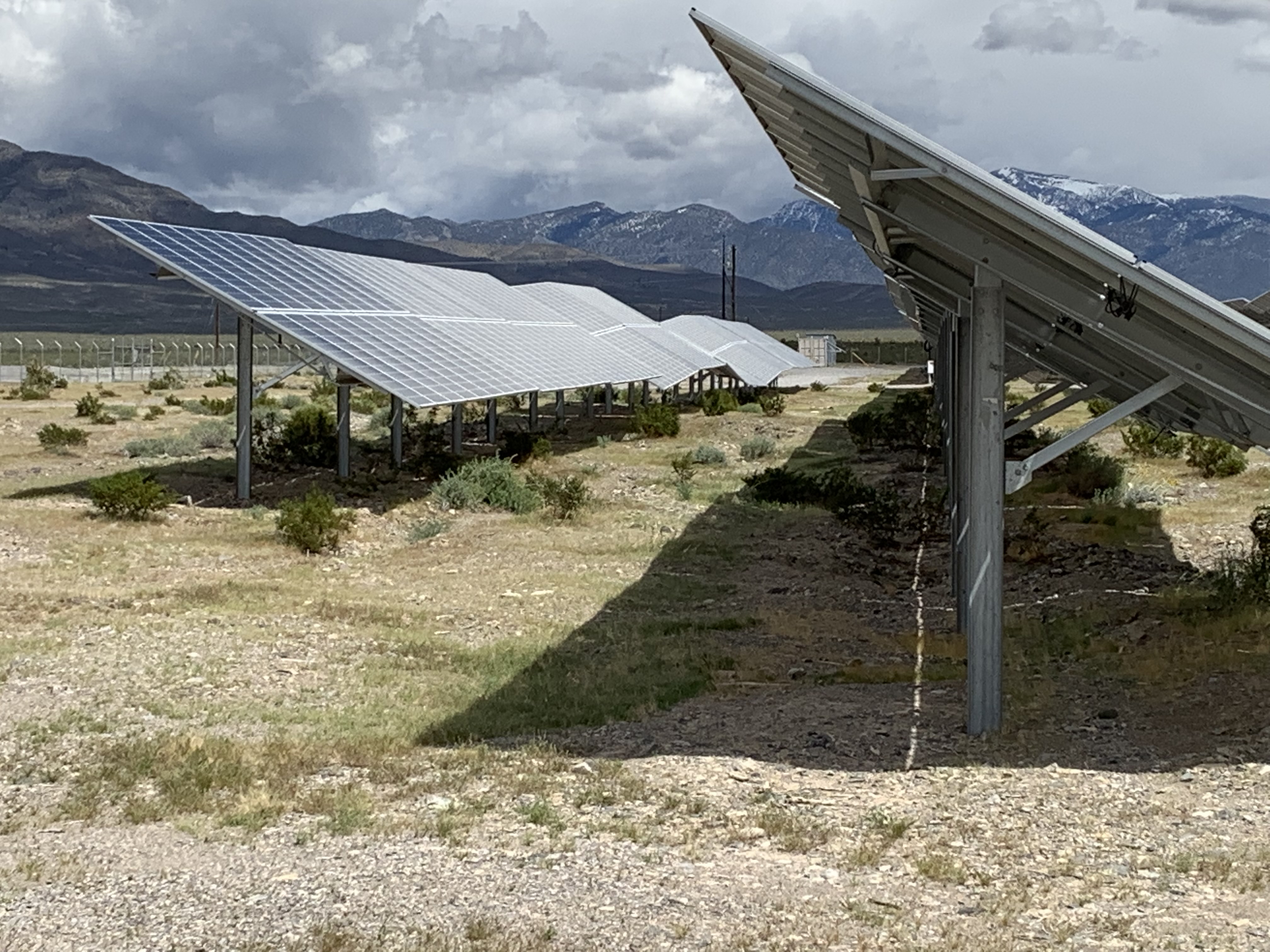
And see our page on the mowed desert at Pahrump Valley Solar Project for how this will likely appear. This is not restoration of a desert ecosystem, but disturbing it and industrializing it.
The better alternative to ruining our public lands and tortoise habitat: parking lot solar structures in urban areas.

Draft Environmental Impact Statement Out for Gemini Solar Project
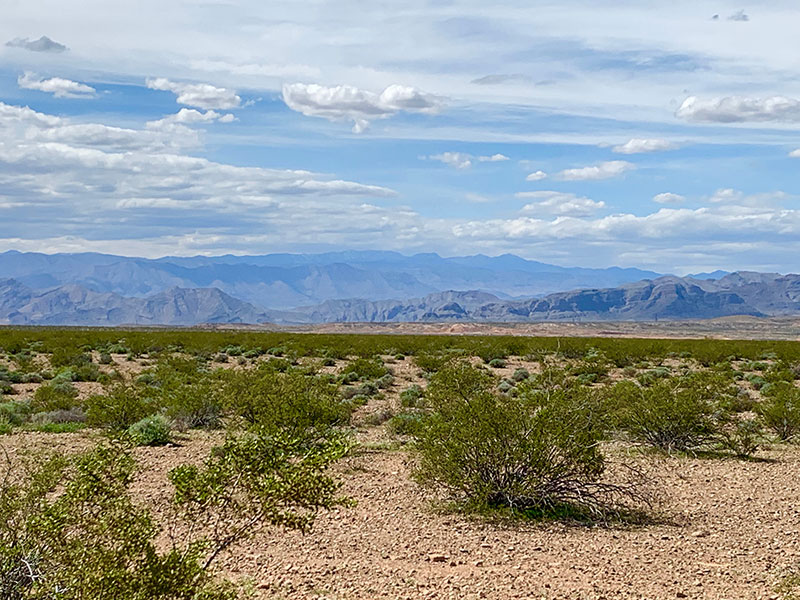
^Site of the proposed Gemini Solar Project looking up from a creosote flat to the Sheep Range in the distance.
June 7, 2018 - The Environmental Impact Statement for the Gemini Solar Project on Bureau of Land Management lands in southern Nevada was released today. The project will potentially be ten square miles (7,100 acres) and nearly 300 Threatened desert tortoise will need too be excavated and moved. The project will be built on the Valley of Fire Entrance Road by the Muddy Mountains Wilderness Area. It will remove rare plant habitat and cover part of the Old Spanish Trail.
Here is the official Federal Register notice for the Draft Environmental Impact Statement for the Gemini Solar Project. We will be following closely.
The Draft Environmental Impact Statement for the Gemini Solar Project can be downloaded >>here.
Basin and Range Watch wrote the cover article for the Sierra Club Desert Report about the Gemini Solar Project. Click here to learn more. The project will take out ten square miles of threatened desert tortoise habitat on public lands near Valley of Fire State Park, Nevada. How can energy be "renewable" when it contributes to the extinction of biodiversity?
Henry Brean wrote an excellent article about the project, interviewing Basin and Range Watch, in the Las Vegas Review-Journal.
Gemini is called a Fast-41 infrastructure project and could get federal funding.
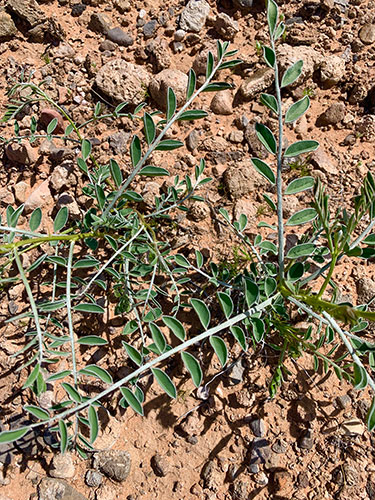
^A milkvetch (Astragalus sp.) leafing out in April, 2019.
See a pdf of our formal petition to list threecorner milkvetch (Astragalus geyeri var. triquetrus) as endangered pursuant to the Endangered Species Act.
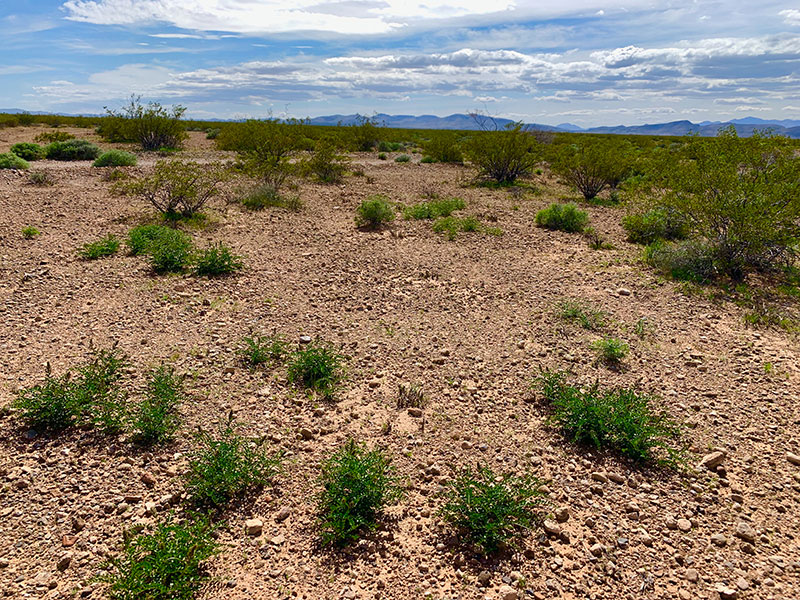
^Many leafy milkvetches were growing after a good rain year on the project site. This area is not proposed to mowed under the solar panel array, but would be bulldozed and graded to contruct the solar field. Some of these milkvetches are rare species.
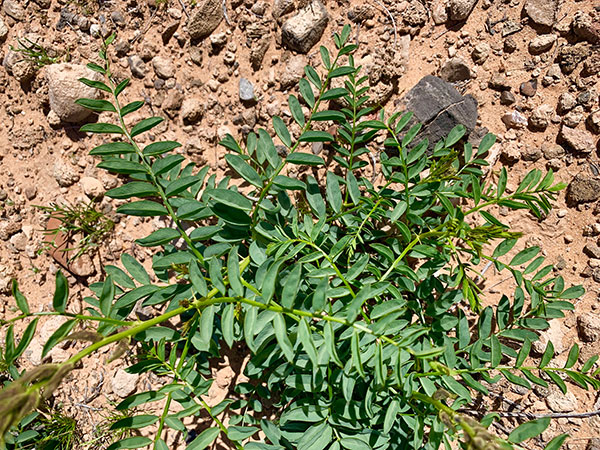
^The diversity of milkvetches is high here.
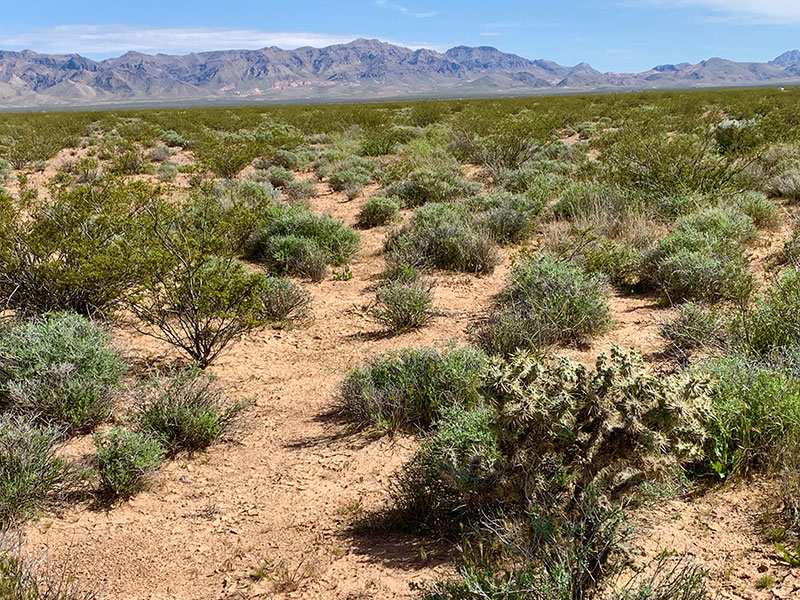
^Diverse Mojave Desert scrub with creosote, lush burrobush, big galleta grass, and silver cholla.
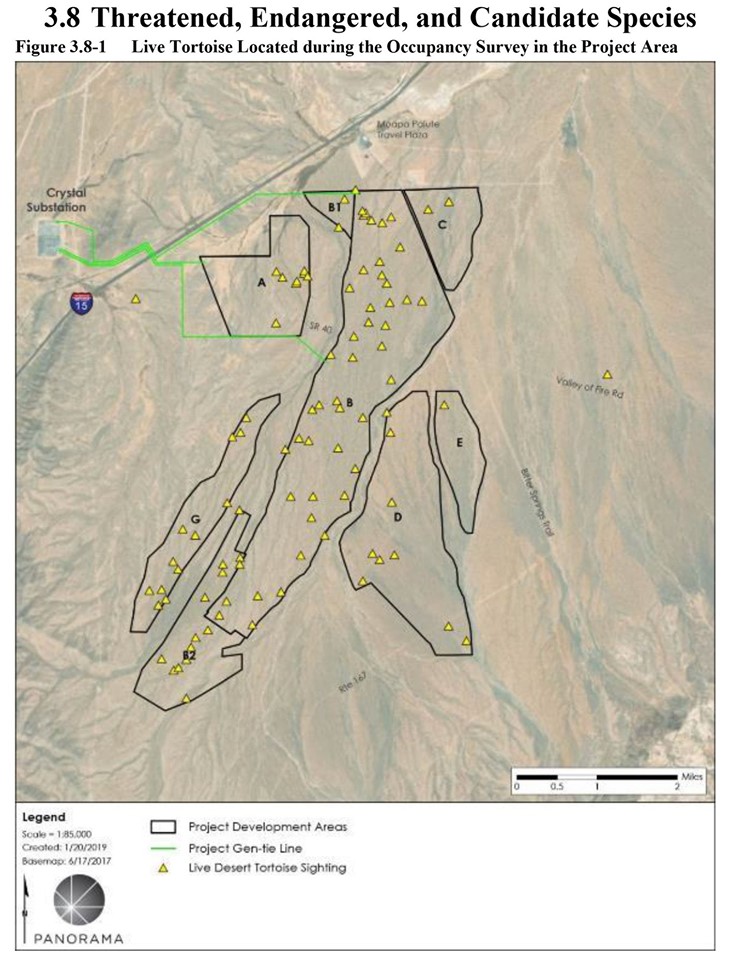
This is the official desert tortoise map for proposed the Gemini Solar Project, Clark County, Nevada. The 7,100 acre site has an even distribution of tortoises. In total, close to 300 will be dug up and moved and there will be probable mortality. Or the BLM could say no to this ill-sited project and solar panels can go on more appropriate locations. One mitigation is to mow the vegetation. Scrapers would run over everything and allow the shrubs to re-grow. But this would still crush every living thing in its path on ten square miles. It is hard to say anything about off-roaders when BLM would allow multi-ton scraper graders to waste the entire site. The photo comes from the Draft Environmental Impact Statement for the project located here.
Gemini Solar Project Will Block Crucial Linkage Corridor for Tortoise
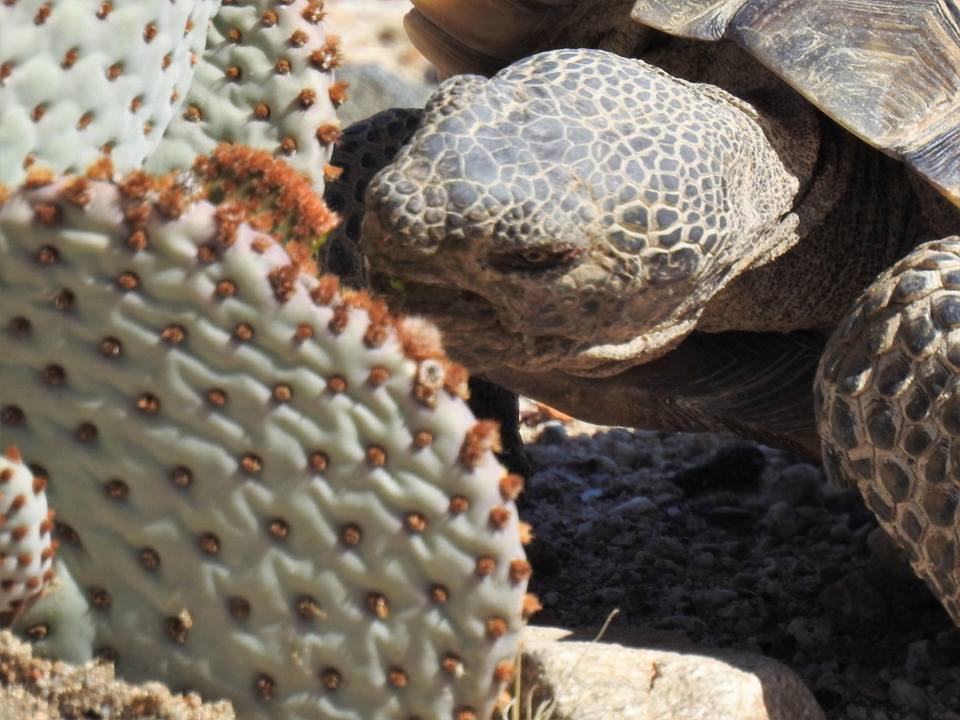
^Desert tortoise (Gopherus aggasizii) dining on beavertail cactus.
March 3, 2019 - California Wash, NV - A "good experiment"?
The Bureau of Land Management (BLM) is saying that the Draft Environmental Impact Statement for the Gemini Solar Project will be released at the end of this month. This will be a 7,000 acre (10 Square Mile) photovoltaic project located on the entrance road to Valley of Fire State Park in Southern Nevada. Aside from being a very scenic area (next to the Muddy Mountains Wilderness) they have estimated that over 260 desert tortoises will need to be excavated and relocated to make way for the project. There has never been a 100 percent success moving tortoises like this at this scale. There will be mortality. The US Fish and Wildlife Service has said this project along with other pressures will fragment a crucial linkage corridor connecting desert tortoise recovery units. But the same folks have told me that they will suggest "mowing vegetation" and allowing tortoises to enter the site. They are not opposing it, but actually told us that would be a "good experiment " The desert tortoise has declined by over 50 percent since 2008. Also found were 99 active kit fox burrows and 14 active burrowing owl burrows. More on the project here:
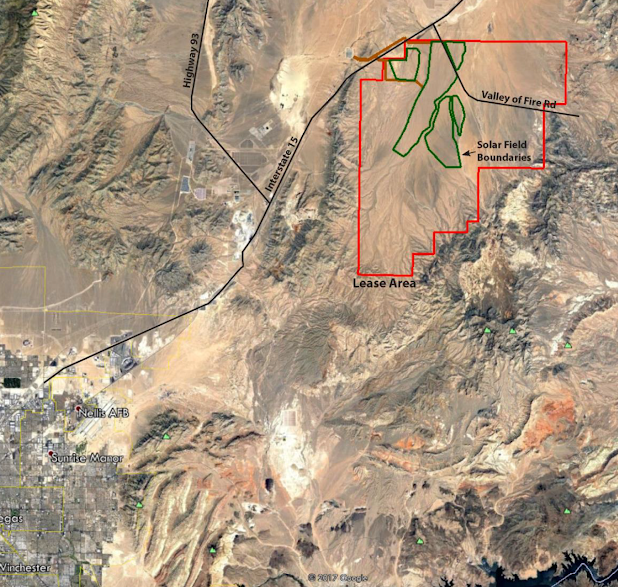
^Map of proposed Gemini Solar Project in high quality desert tortoise habitat.

^Mojave Desert Tortoise habitat and linkages. The blue areas are crucial genetic connectivity corridors, and the Gemini Solar Project would block one connecting Recovery Units. From a February 27
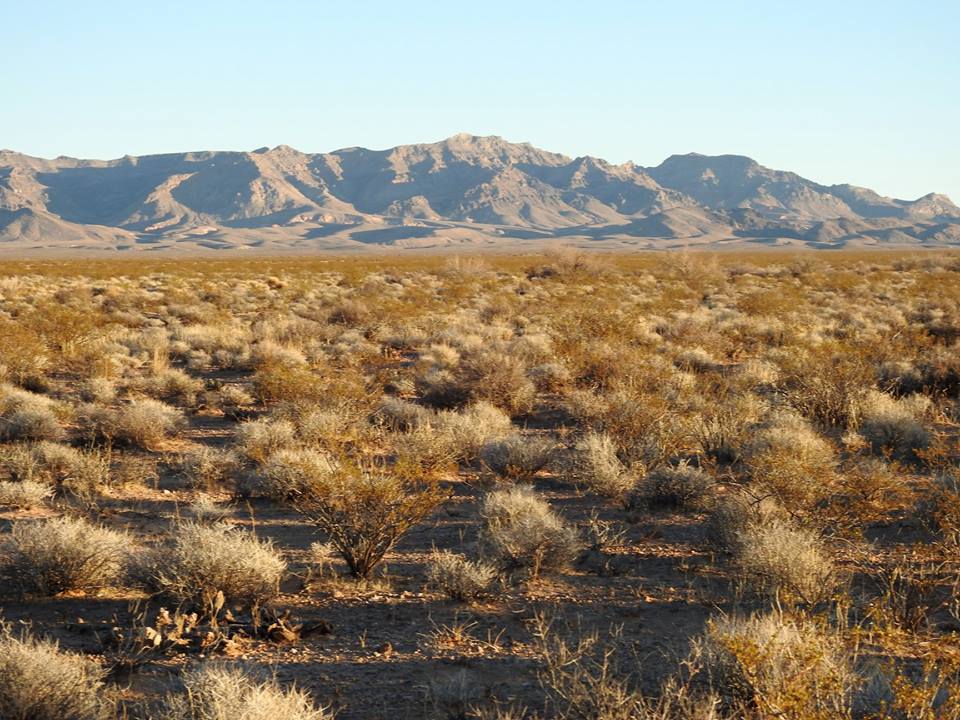
^High quality desert tortoise habitat at the proposed Gemini Solar Project site in California Wash, with the Muddy Mountains Wilderness Area in the distance.
Gemini Solar Project Would Mar Vista at Valley of Fire State Park and Muddy Mountains Wilderness

^Muddy Mountains Wilderness. (Photo: Jim Boone, http://www.birdandhike.com/Wilderness/MuddyMts/_Muddy.htm)
July 16, 2018 - Clark County NV - The Bureau of Land Management (BLM) is accepting initial scoping comments for the Gemini Solar Project - a 7,000 acre photovoltaic solar facility that would be located on the entrance road to Valley of Fire State Park, Nevada. Under the Trump administration’s America First Energy Plan, the BLM will potentially allow Arevia Power to blade 10 square miles of great quality desert tortoise habitat on public lands and replace everything with rooftop compatible solar panels. The project would impact the adjacent Muddy Mountains Wilderness Area and Bitter Springs Backcountry Byway so much that the BLM wants to downgrade the Visual Resource Management class to approve the project. The project site has microphyll woodlands and in 2013, the Moapa Solar Project across the basin on the Moapa Reservation excavated 157 tortoises before construction. This project will be over 3 times larger. Comments are being accepted until August 27th, 2018. Click on this link to comment: https://www.blm.gov/press-release/blm-seeks-comments-gemini-solar-project-near-las-vegas
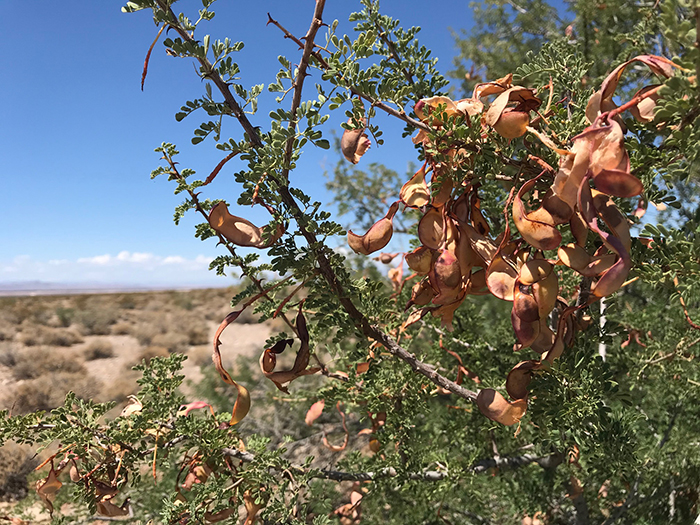
^Catclaw acacia (Senegalia greggii) with pods, on the project site. These small trees will need to be bulldozed and removed to make room for millions of photovoltaic panels.

^Catclaw acacia in small washes that cross this Mojave Desert basin, with the Sheep Range in the distance.
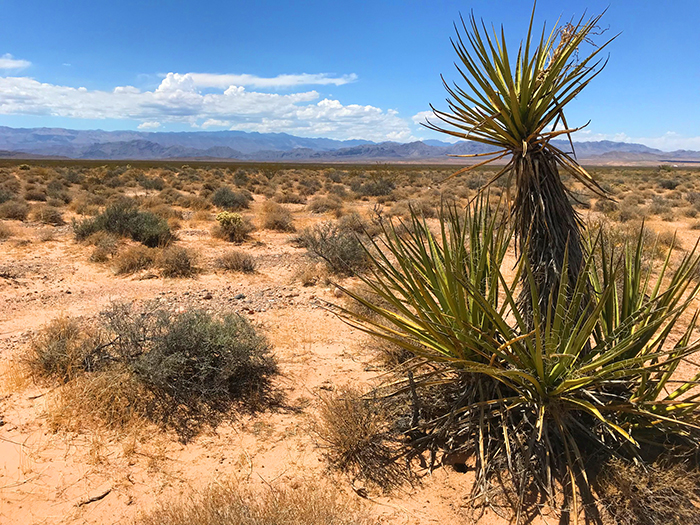
^A few Mojave yuccas (Yucca schidigera) grow on the site. Will these be shredded or transplanted?

^Map of the Gemini Solar Project proposed Right-of-Way in red, and the first phase solar fields that could be built in green. Our field marks of dirt roads in this scenic area are in pencil.
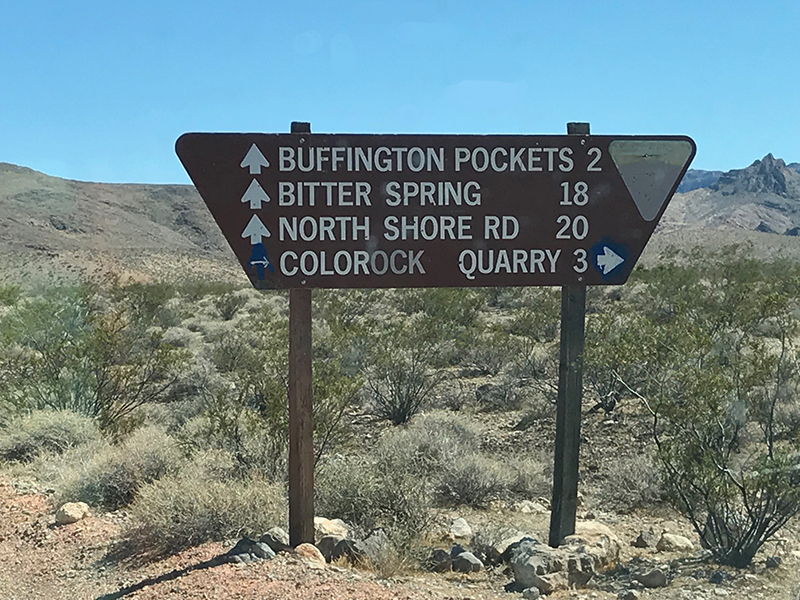
^Scenic 4x4 routes and destinations on BLM here.
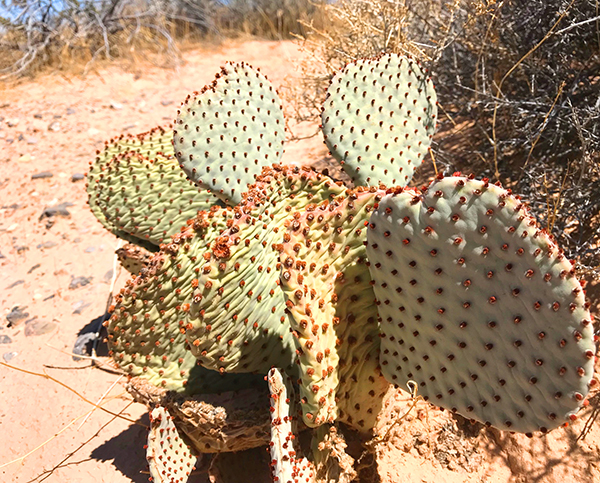
^Beavertail cactus (Opuntia basilaris).
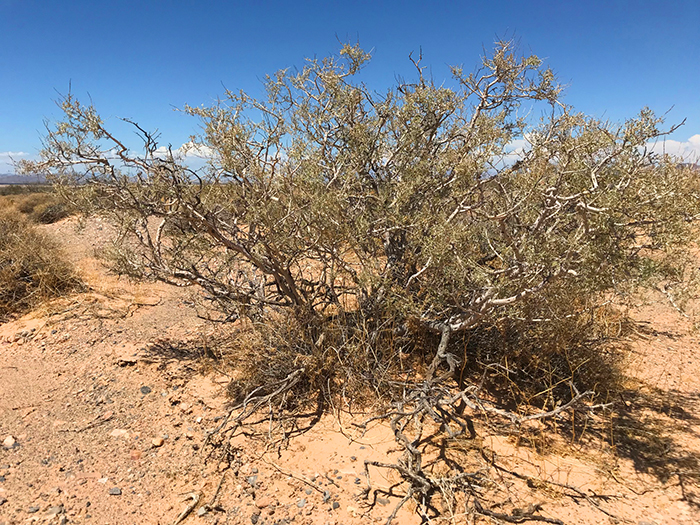
^Large indigo bushes (Psorothamnus arborescens) grow along washes here. They have deep violet blossoms in the spring.
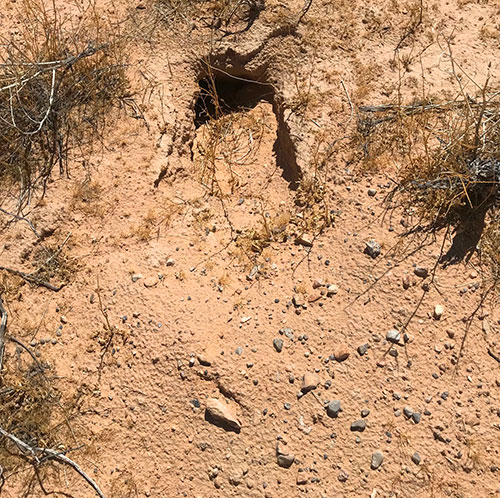
^We found two desert tortoise burrows on a visit--this site is excellent tortoise habitat and large numbers will be dug up and need to be translocated if the project is built. Given the huge cumulative impacts across the range to tortoise habitat with military base expansions, other utility-scale solar and wind projects, and the proposed Northern Corridor through the Red Cliffs tortoise preserve, this area should be conserved as Critical Hbaitat.
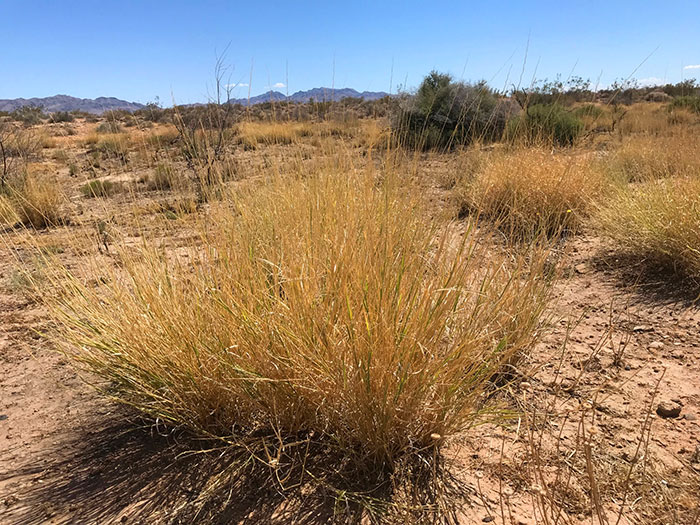
^Big galleta grass (Hilaria rigida) is common in washes--a favored tortoise food.
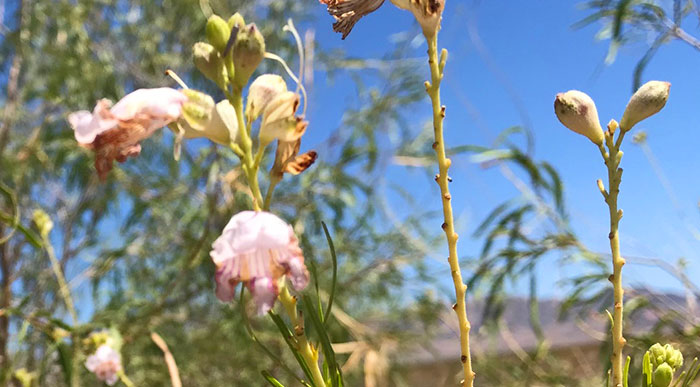
^Desert willow (Chilopsis linearis) blossoms.

^Desert willows are unusually common on the Gemini Solar Project site proposal. These will be bulldozed if a better alternative is not chosen.
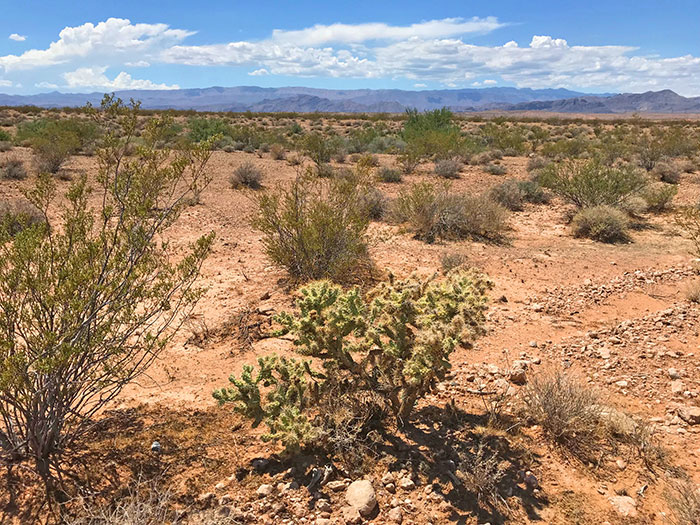
^Silver cholla (Cylindropuntia echinocarpa). This whole scene will be convreted to solar panels if allowed to be built.

^Rocky wash with catclaw acacia coming out of the Muddy Mountains.

From the proposed solar project looking eastward to the Muddy Mountains Wilderness Area.

^Catclaw acacia.
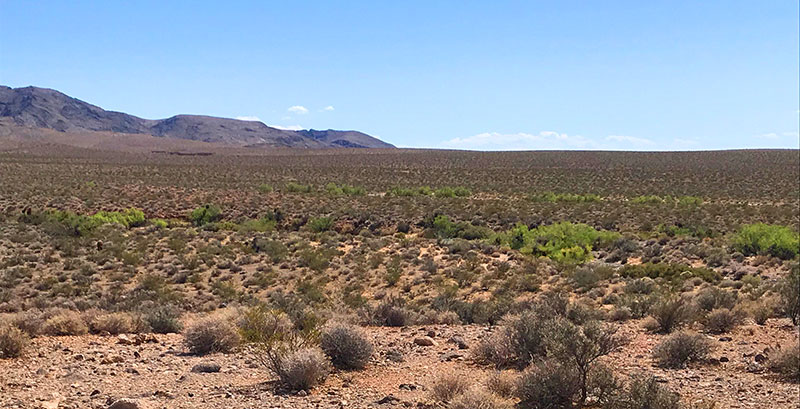
^Vista of the proposed Gemini Solar Project site next to the Muddy Mountains.
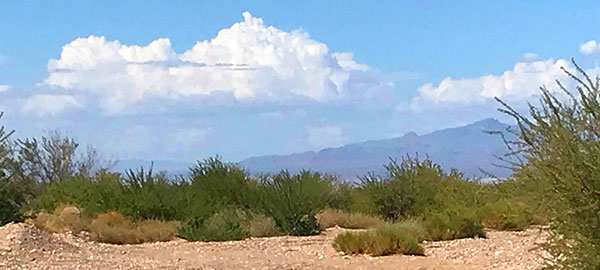
^Large wash with catclaw acacia and desert willow. The Mormon Mountains are in the distance.
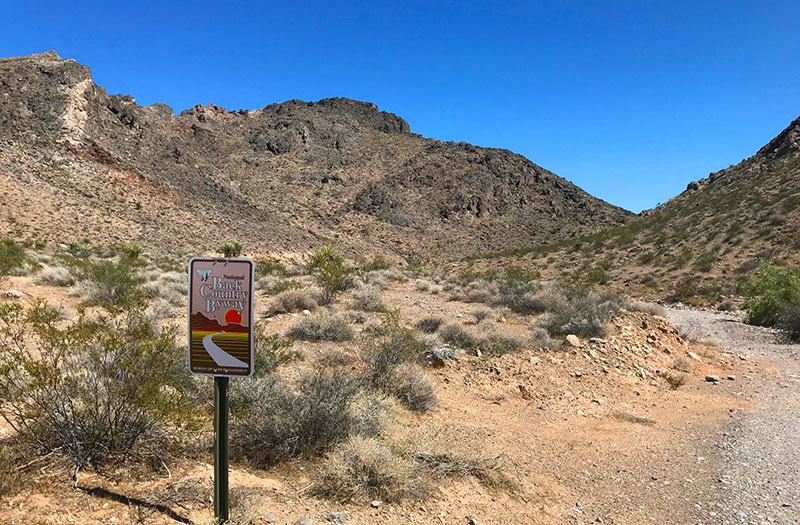
^Scenic back country byway entering the Muddy Mountains.
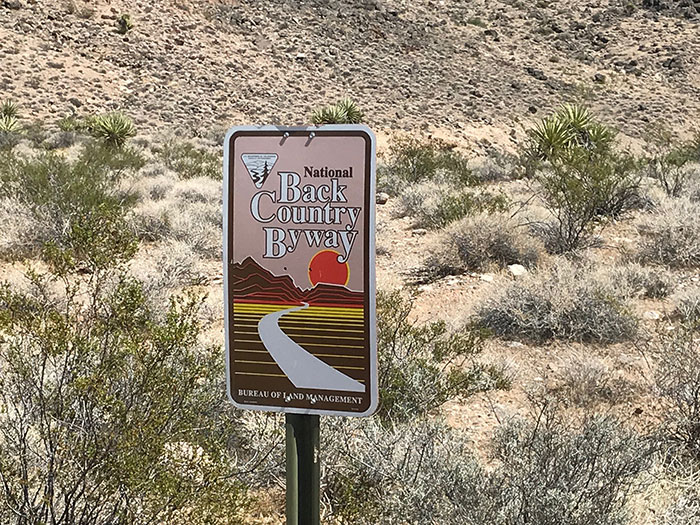
^The scenic area will be industrialized with an energy-sprawl development if this project is permitted on public land.
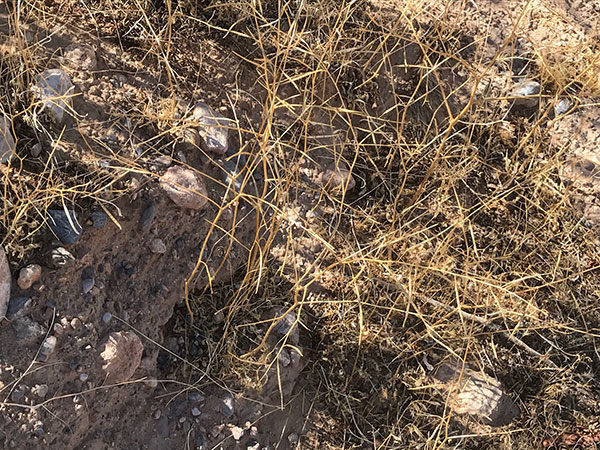
^Dry Sahara mustard (Brassica tournefortii), an introduced invasive weed that could explode with ground-distrubing construction activities.
